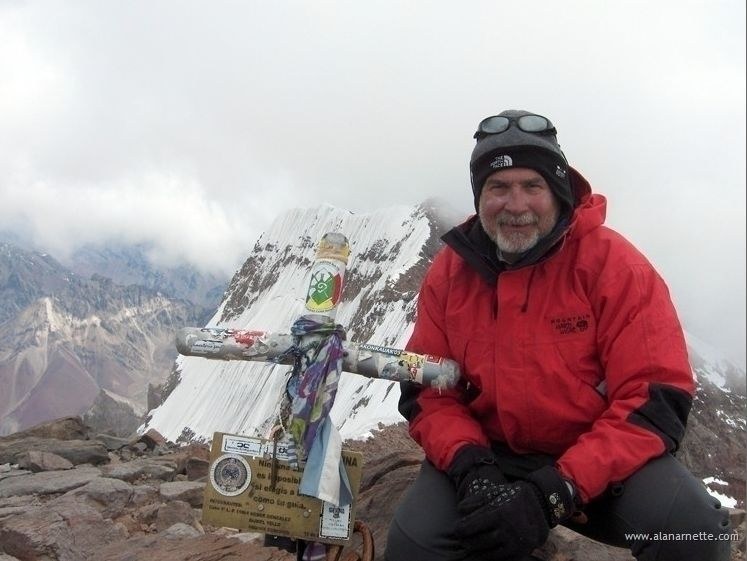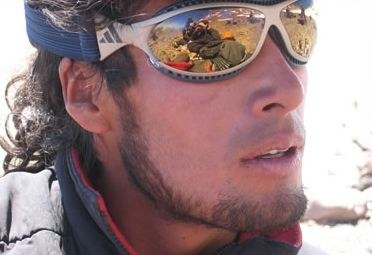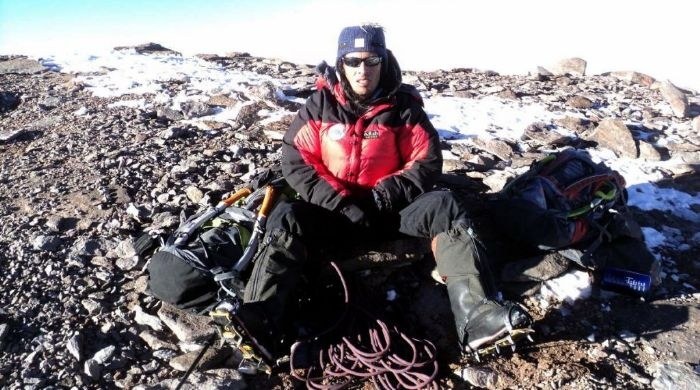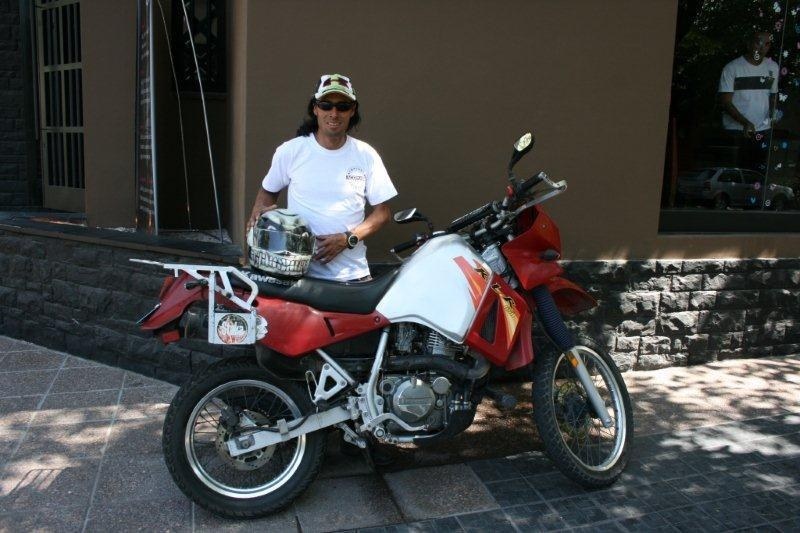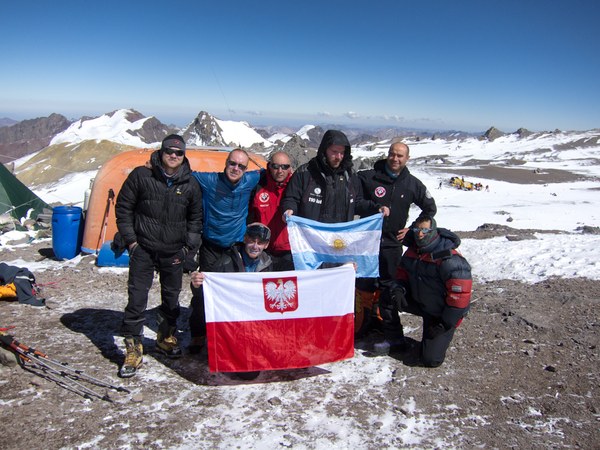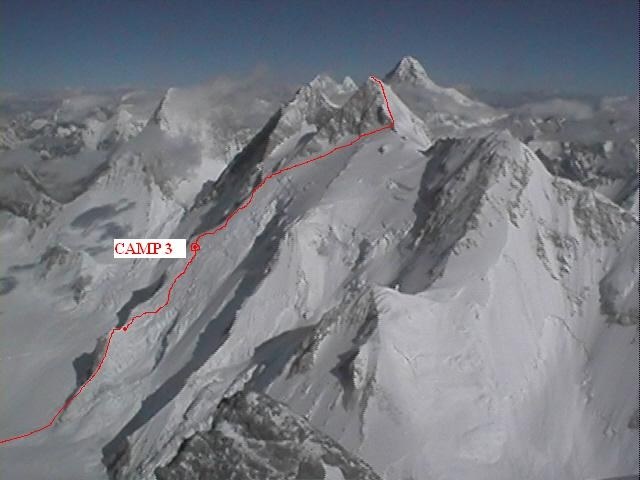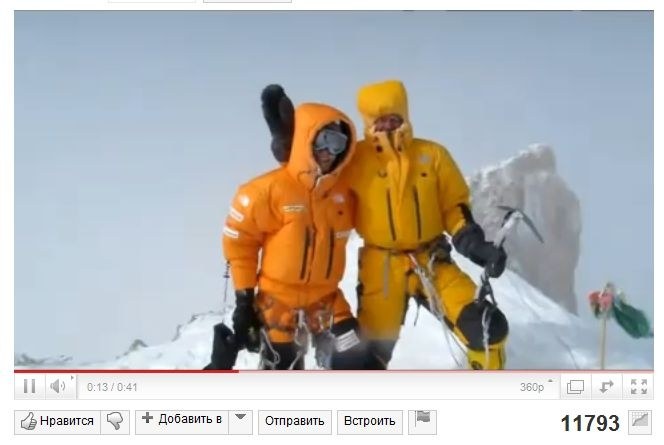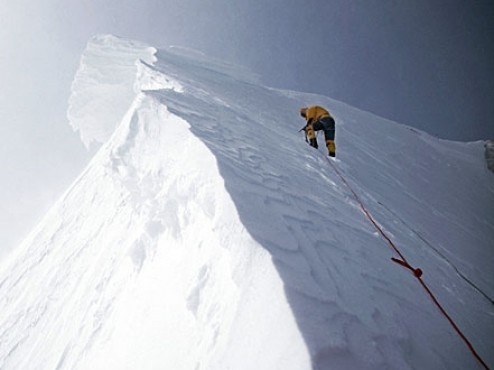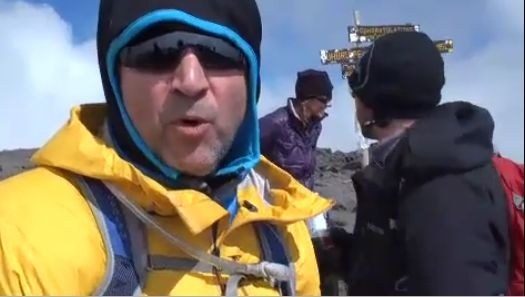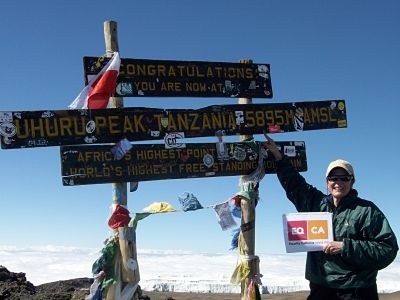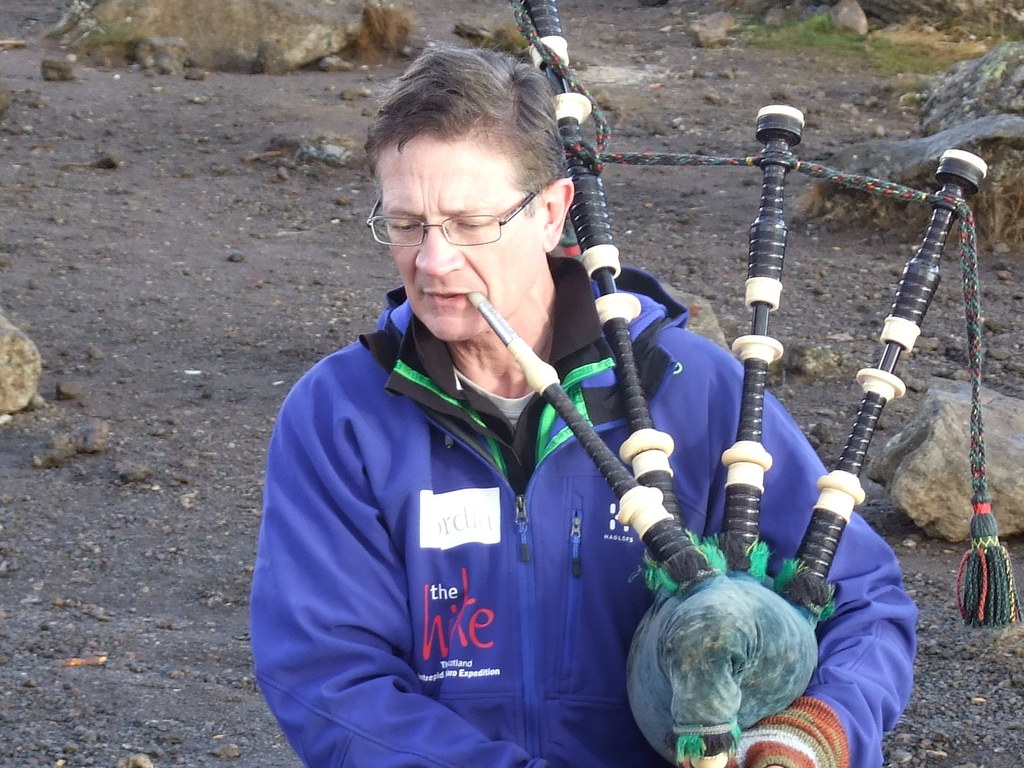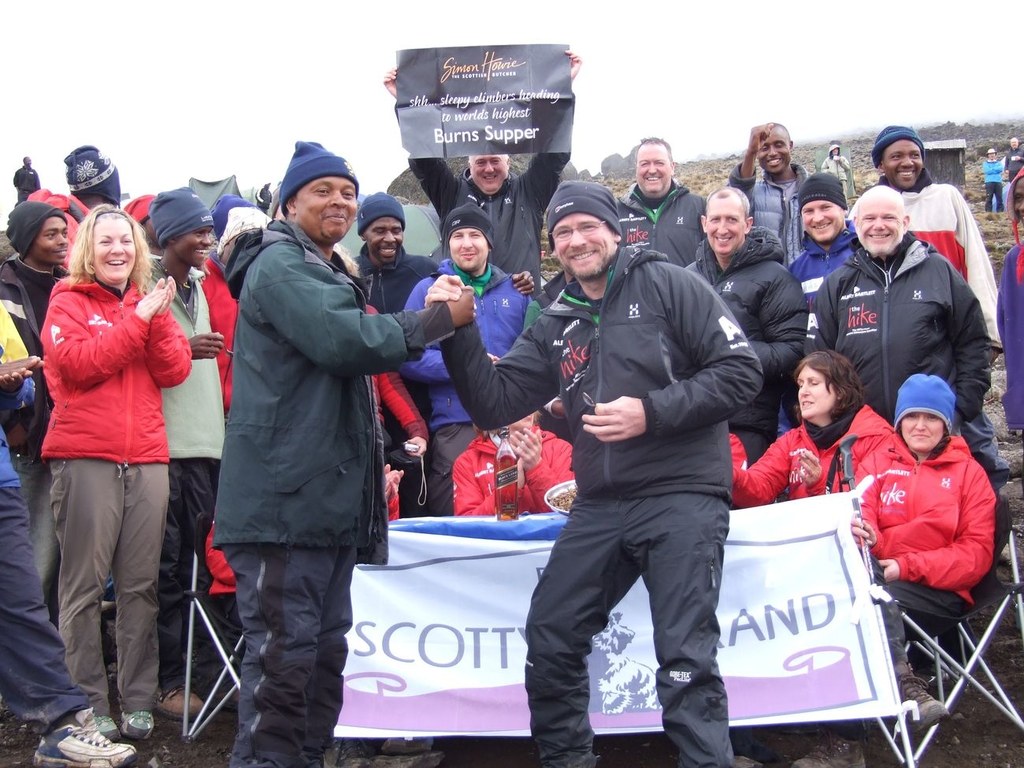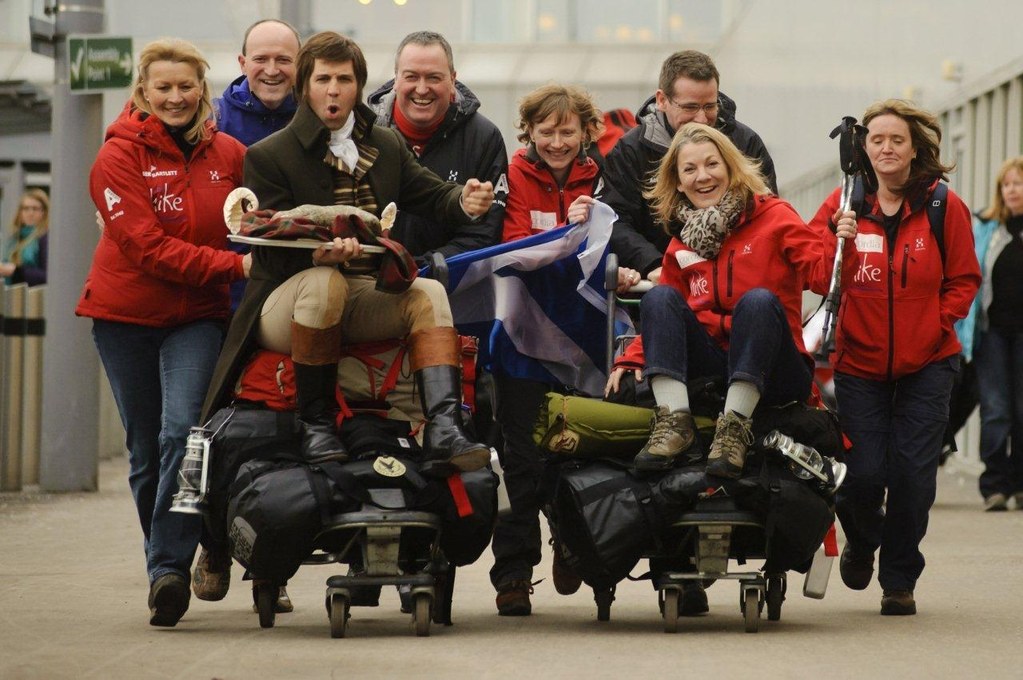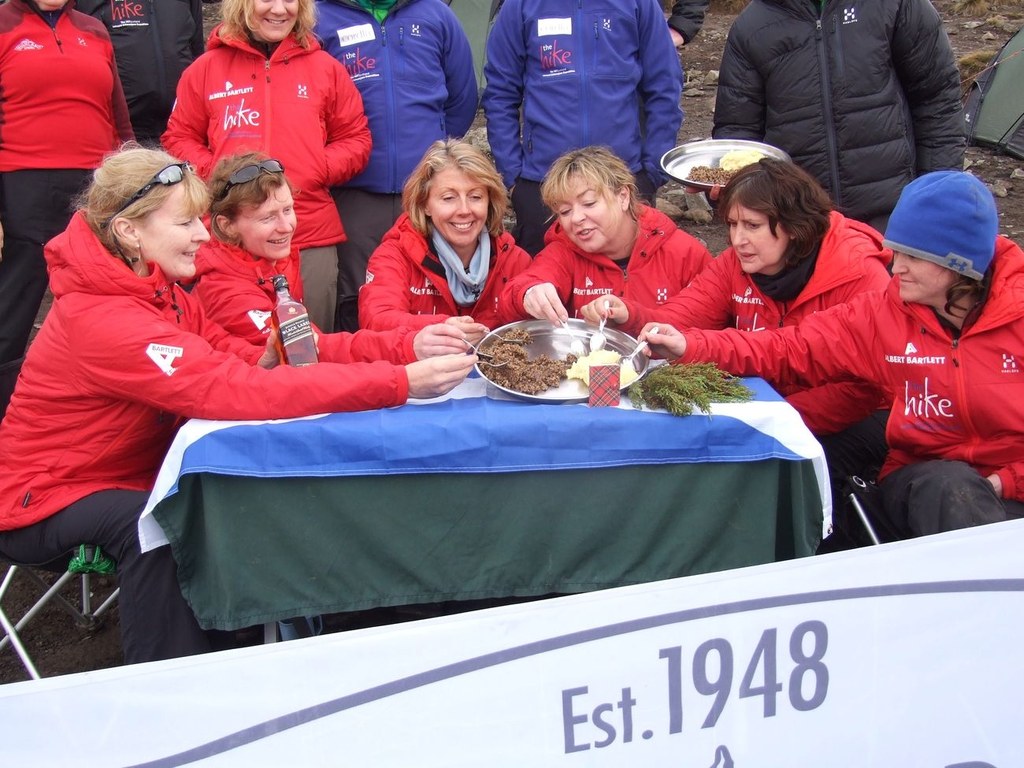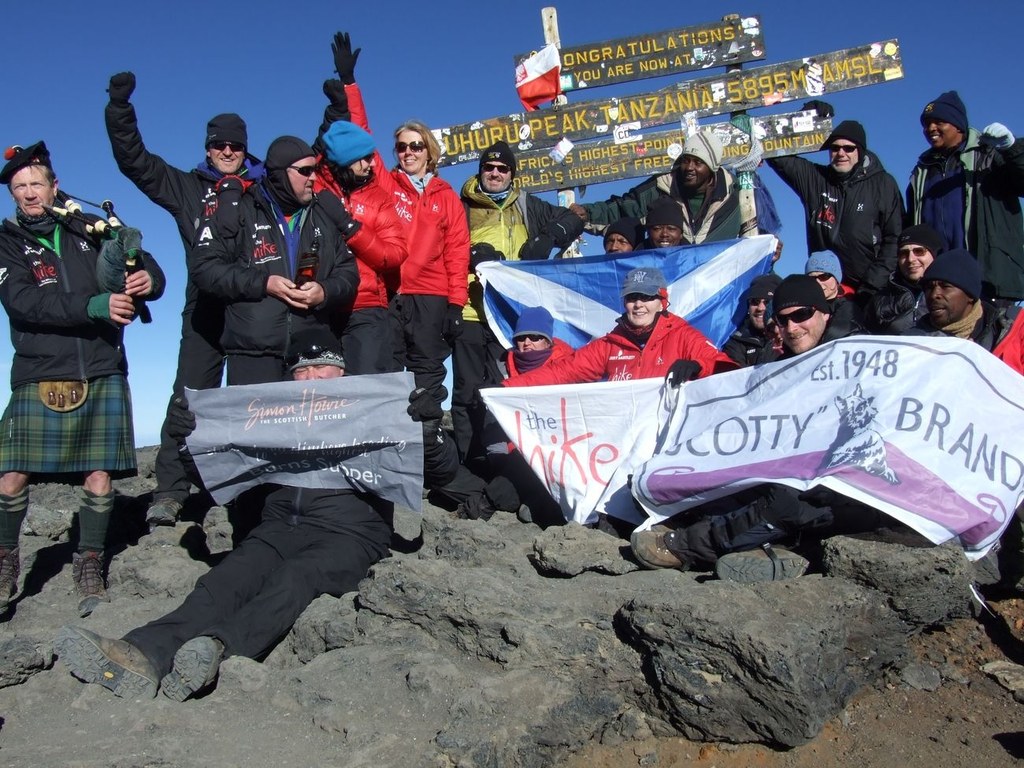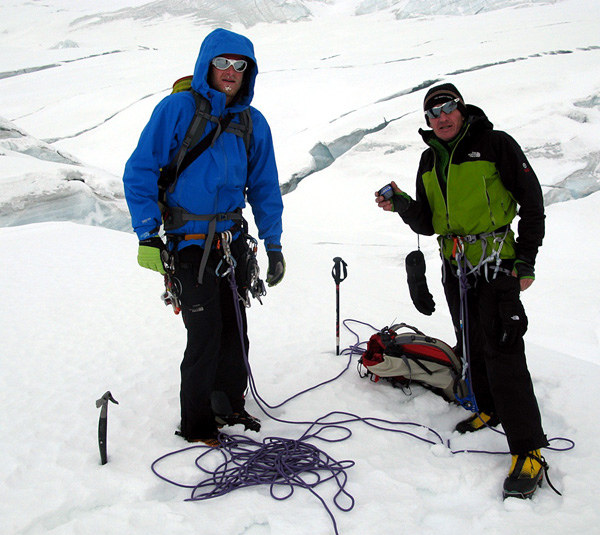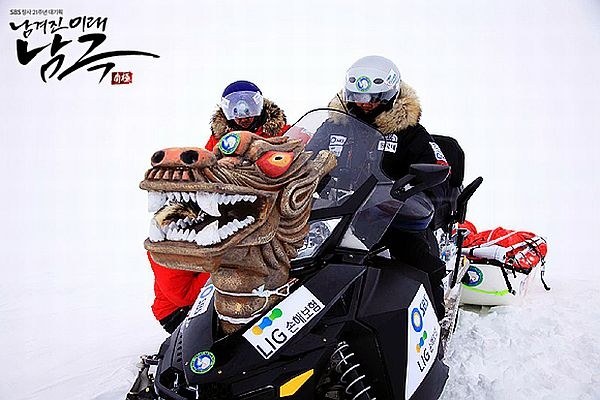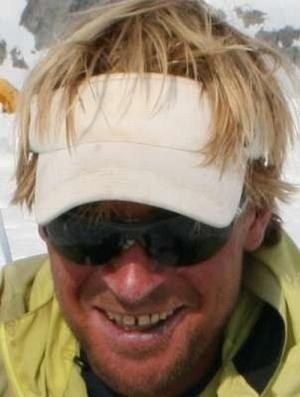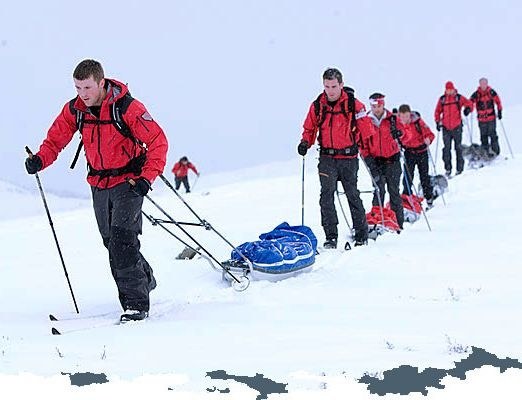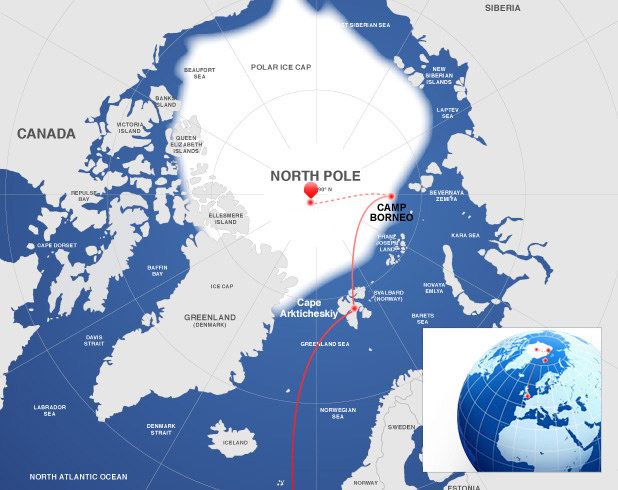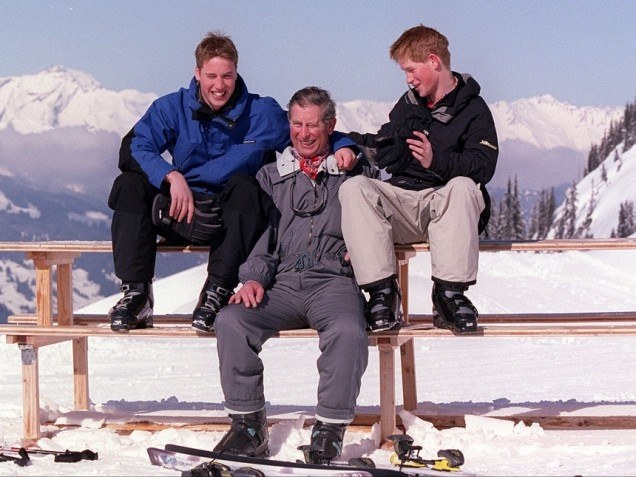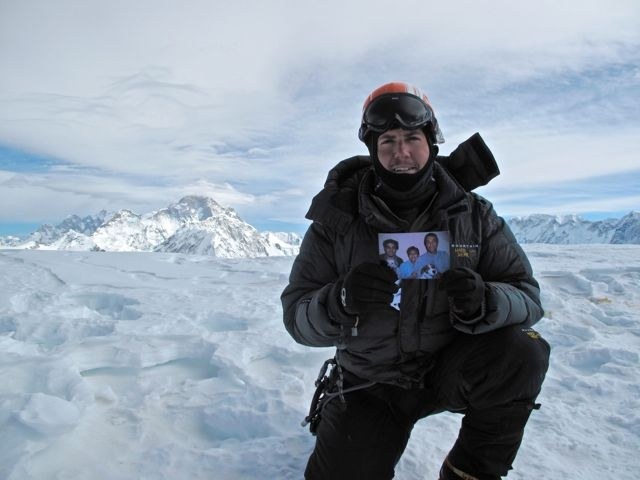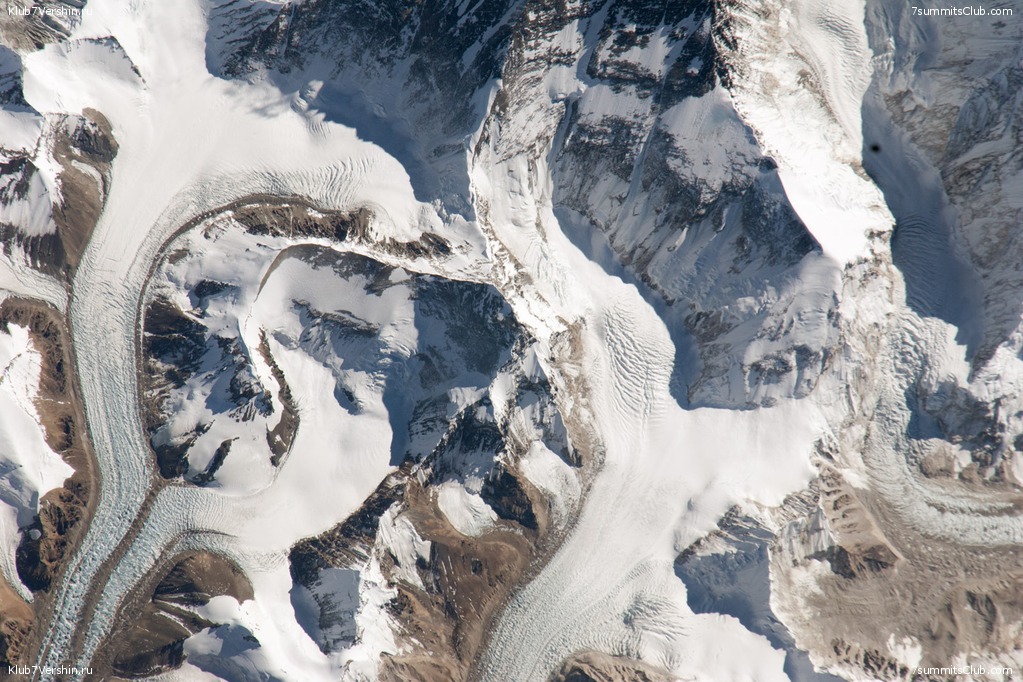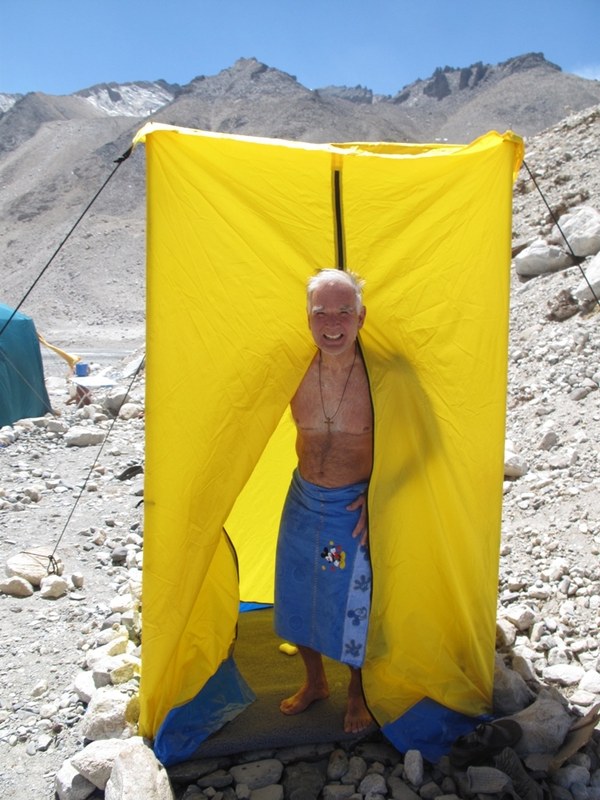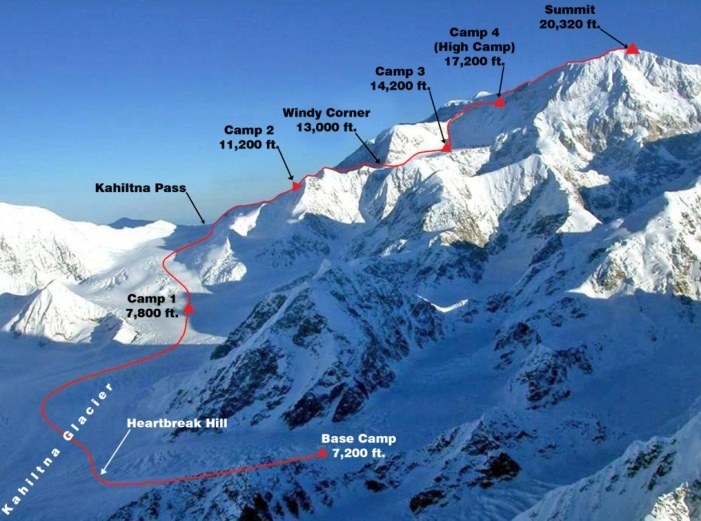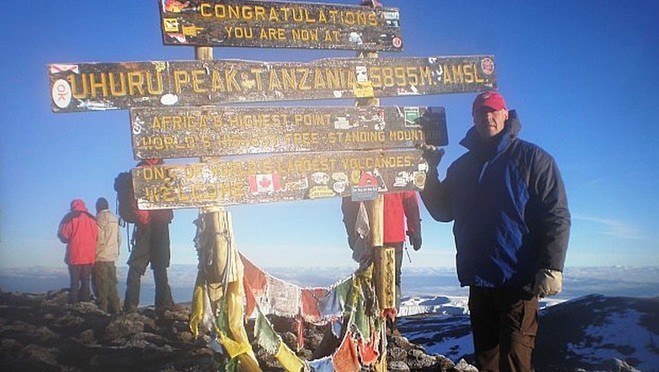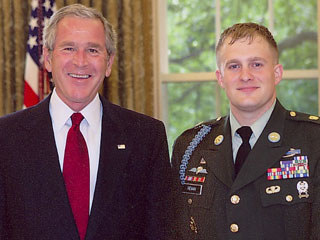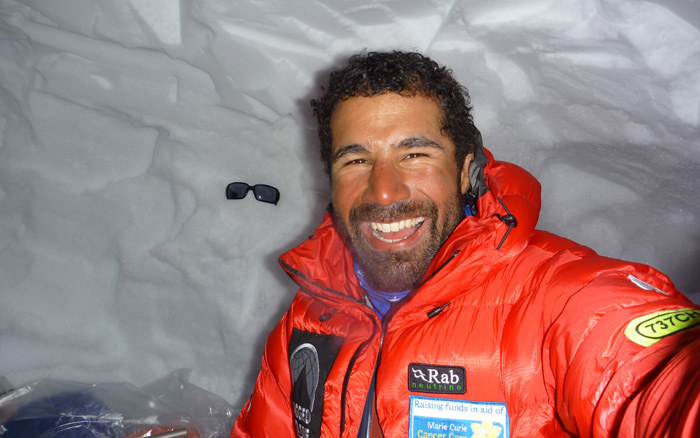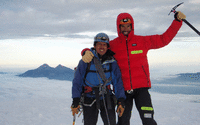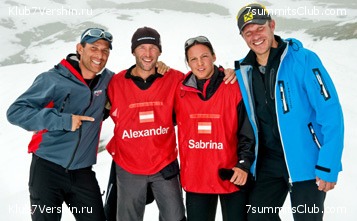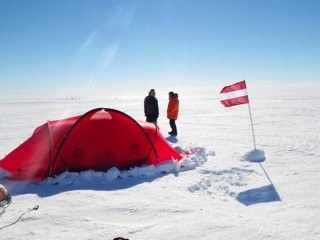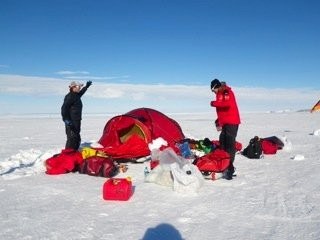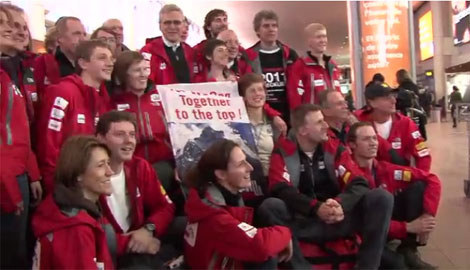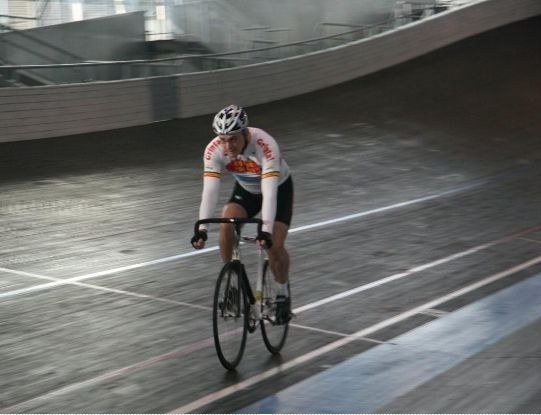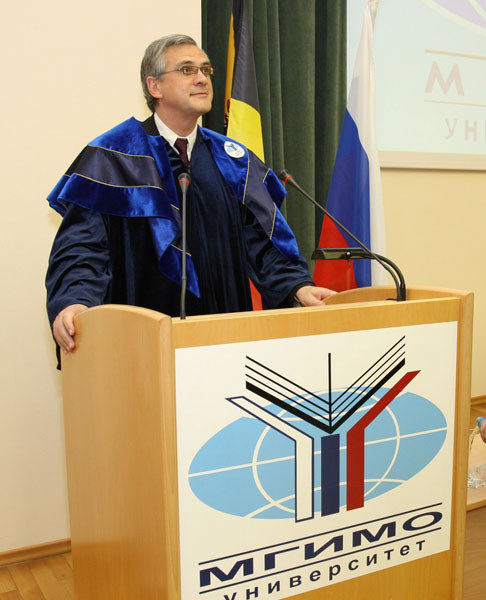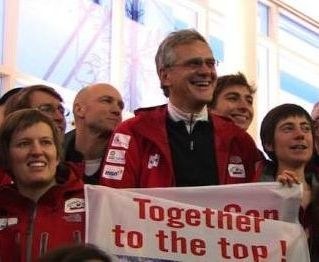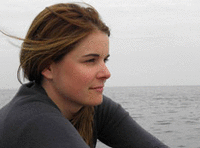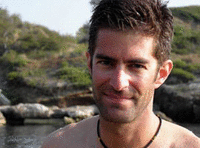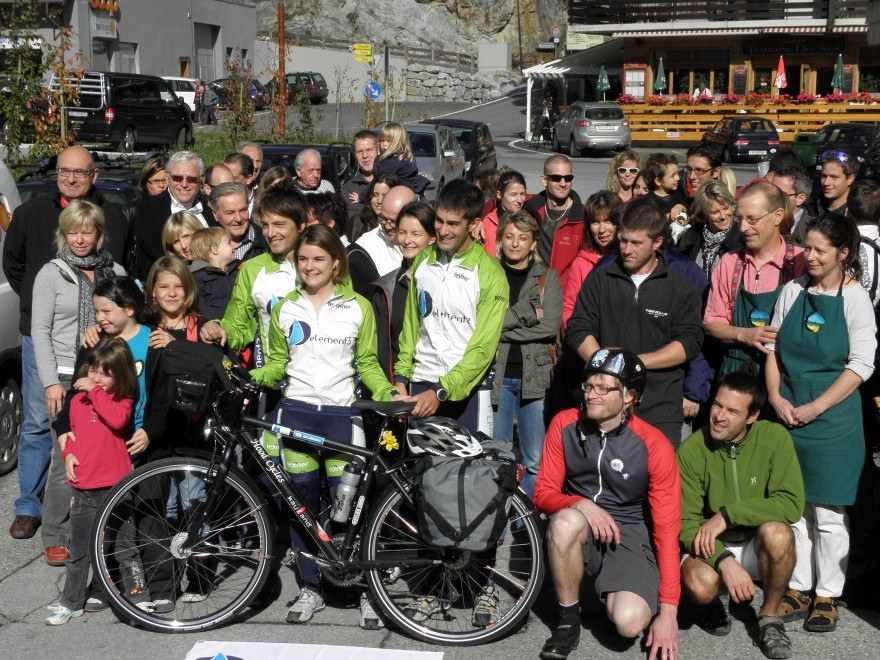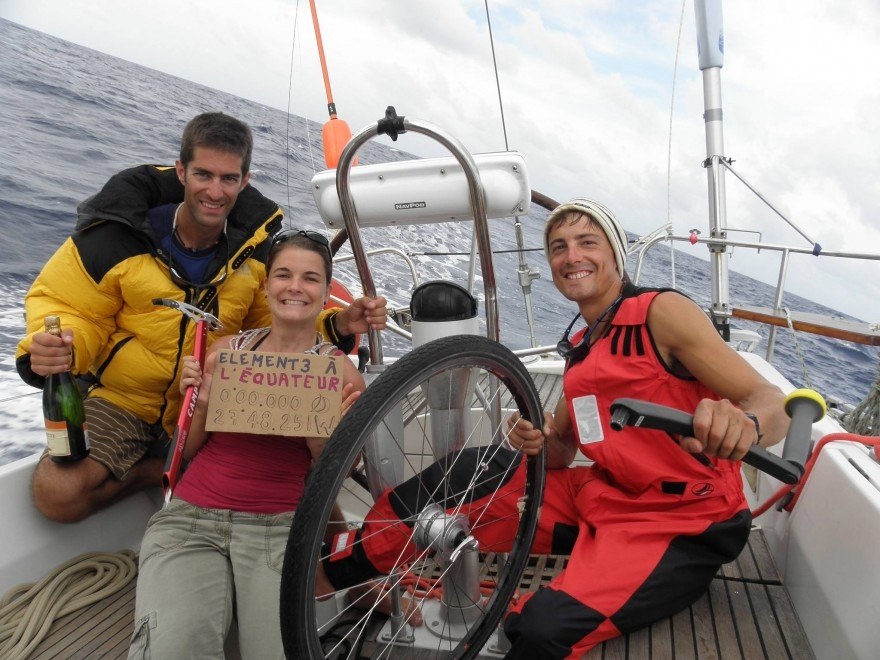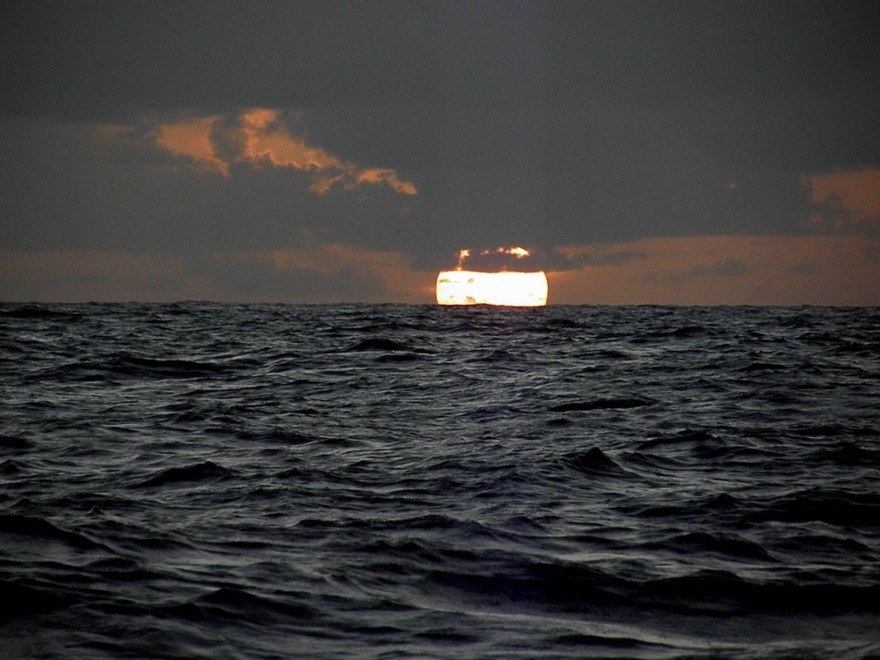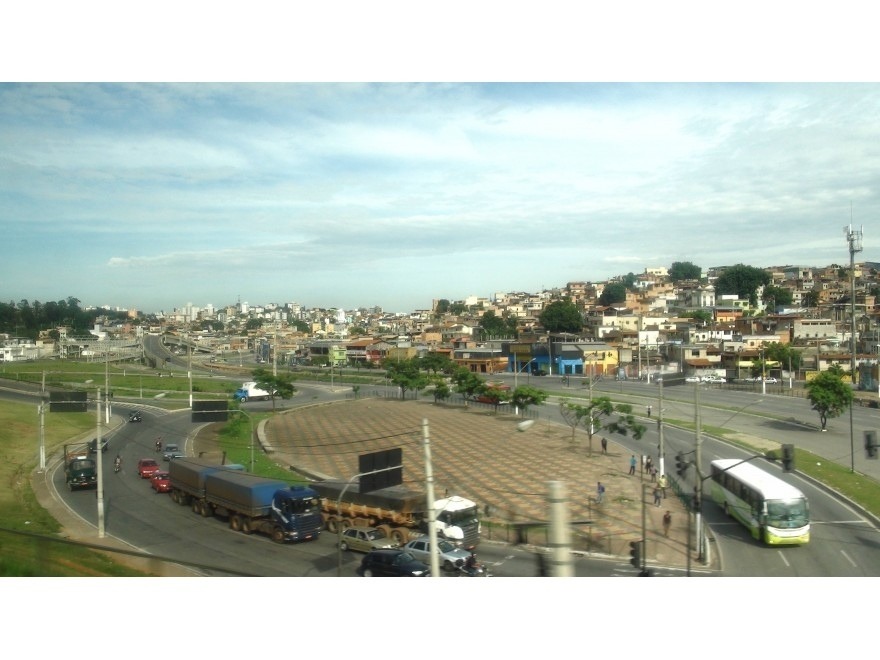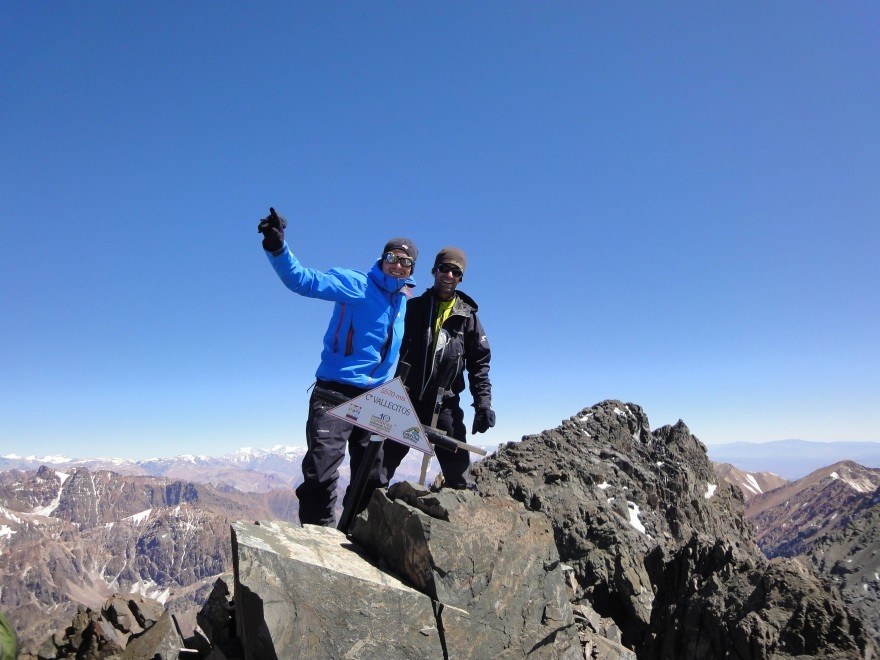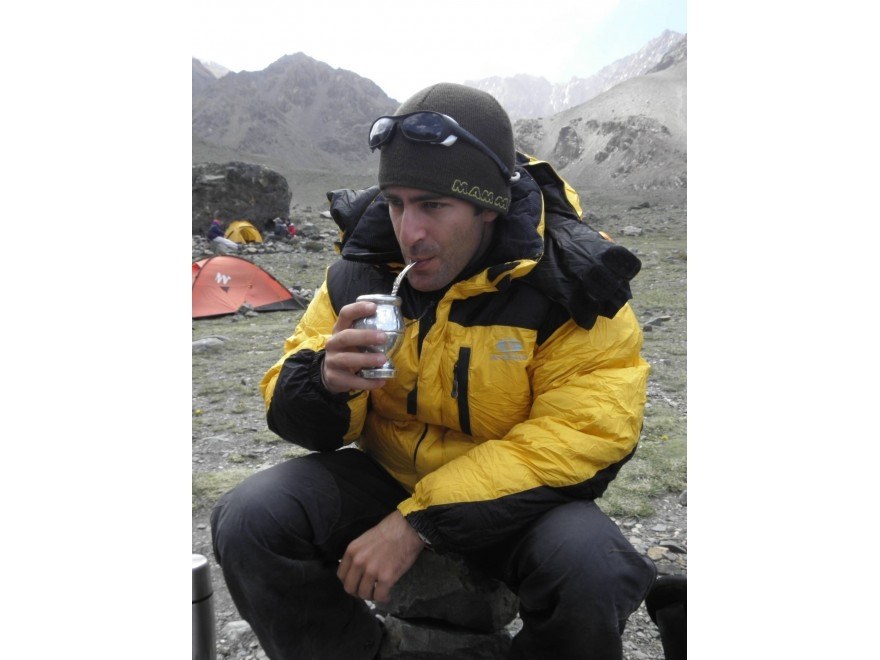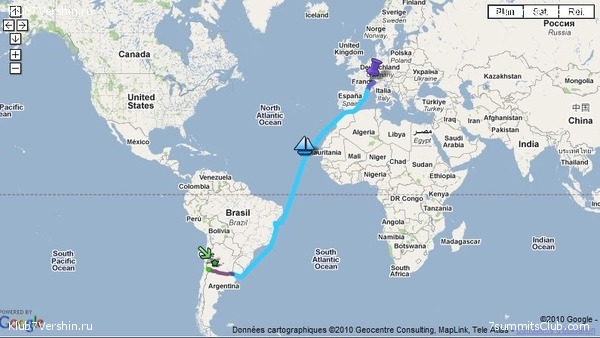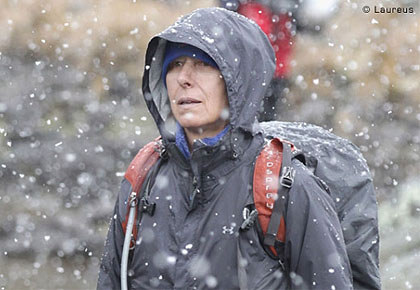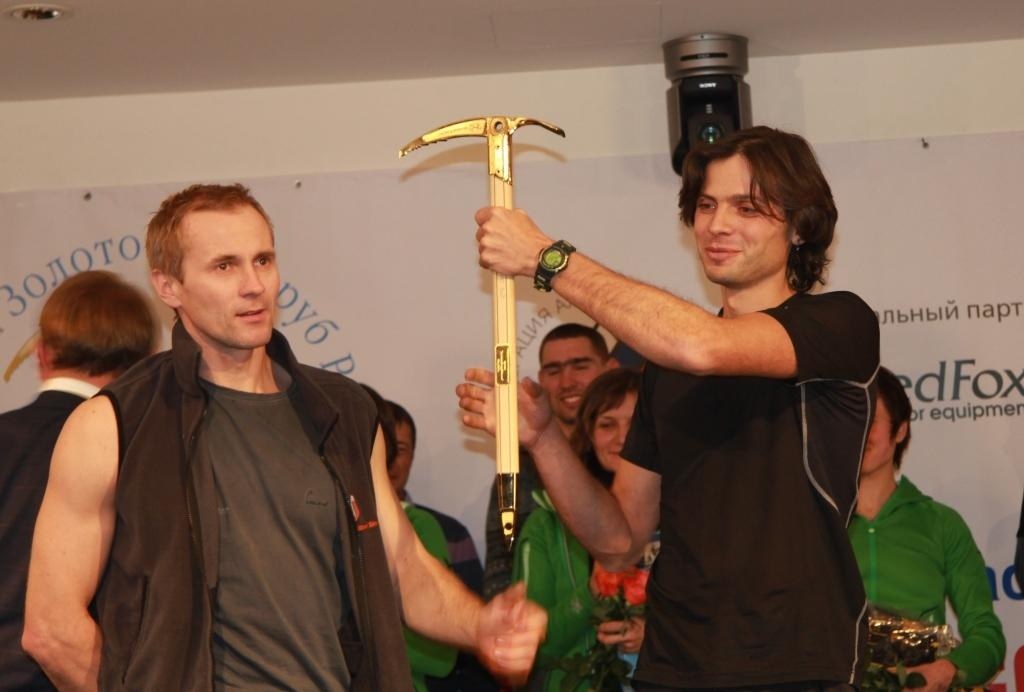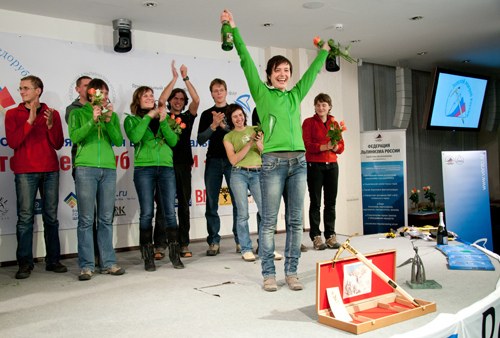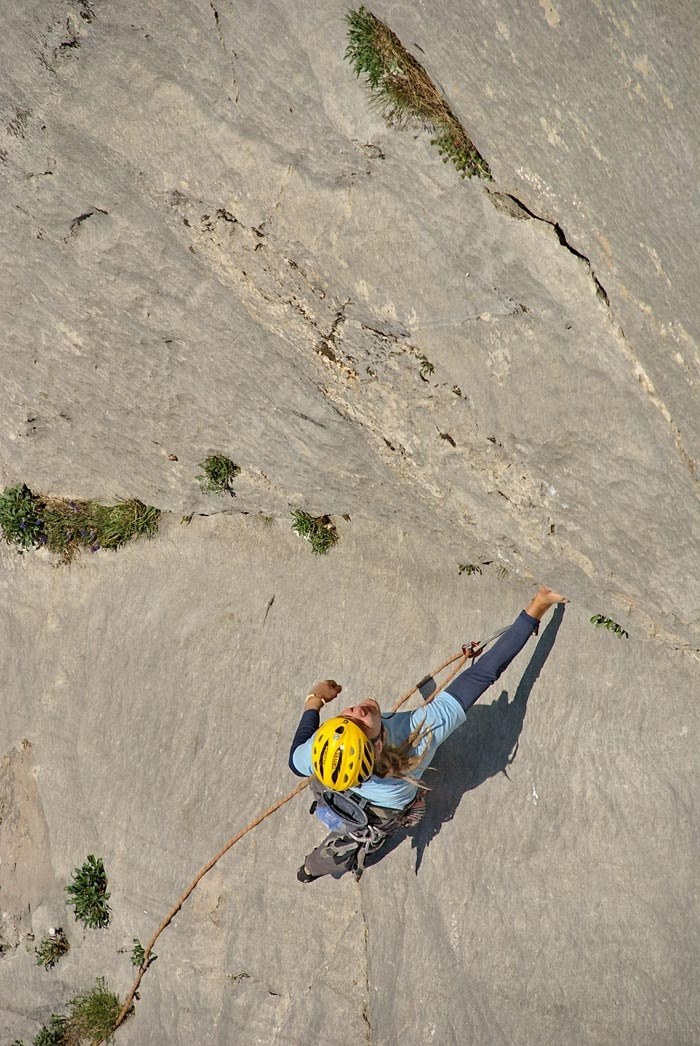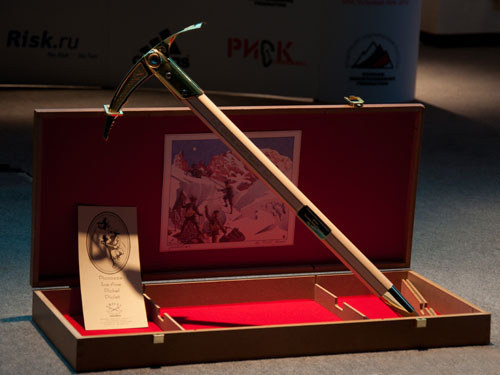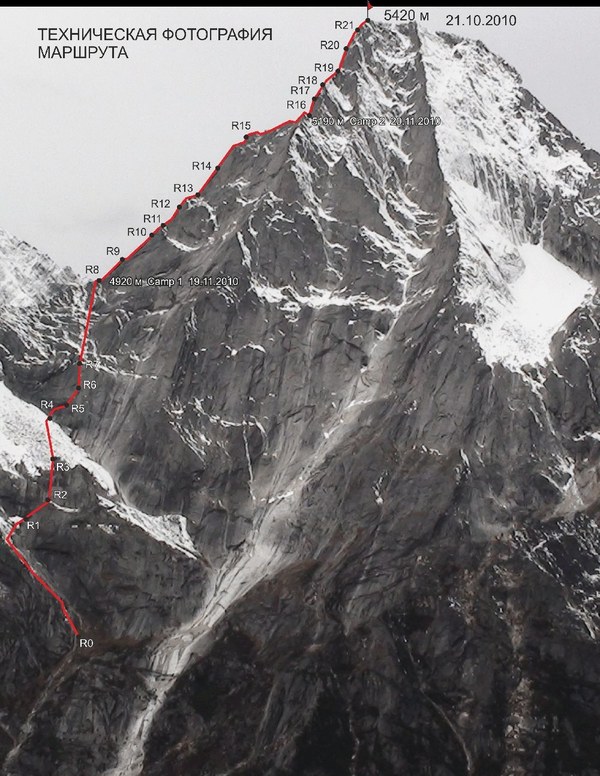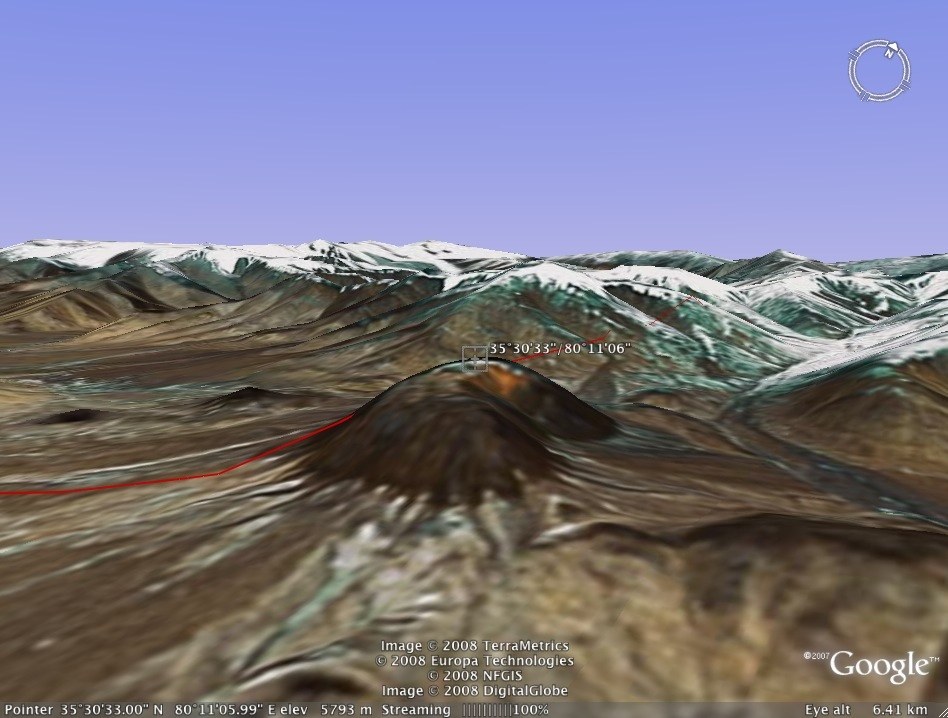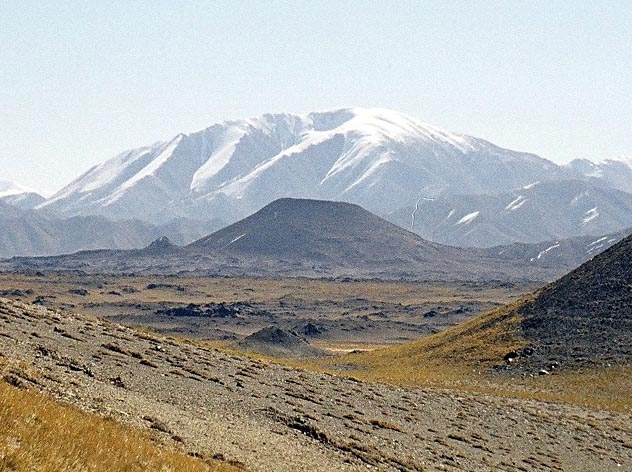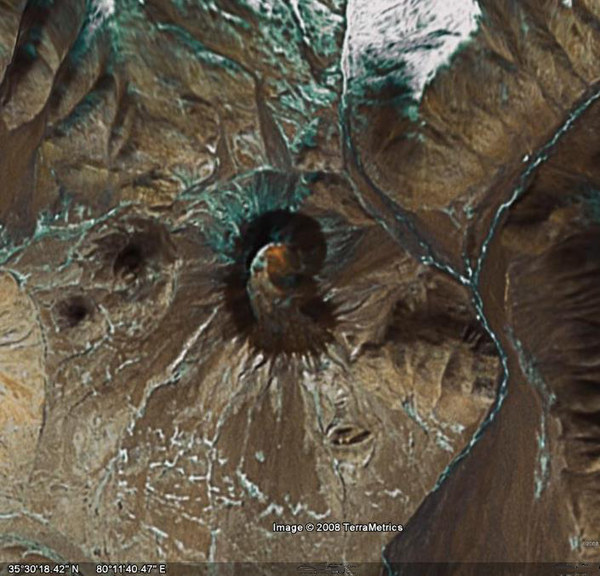World mountain's news
While Victor Bobok discovered America or what is the news on Aconcagua ...
Aconcagua.
While Victor Bobok, in anticipation of the final group of the 7 Summits Club on this season, travels to cities and beaches of South America, we'll monitoring some interesting events that have occurred on the slopes of the highest mountain ...
While Victor Bobok, in anticipation of the final group of the 7 Summits Club on this season, travels to cities and beaches of South America, we'll monitoring some interesting events that have occurred on the slopes of the highest mountain in South America in the last few weeks.
Richard Parks has beaten the weather to reach the second summit of his epic challenge to climb the highest peaks on all seven continents and trek to both Poles. The former Newport Gwent Dragons player reached the summit of Aconcagua, the highest peak in South America, on Saturday at 2.54 pm local time.
Rapidly deteriorating weather meant that Parks had to decide whether to risk gale-force winds in order to reach the summit of the 22,830ft Argentinian peak. Before scaling the summit, Parks said: "These kind of decisions are always tricky and need to be talked through at length. I am lucky to have the expert guidance of our experienced leaders as well as a good team."
The former Wales international is aiming to raise £1m for Marie Curie Cancer Care through his 737 Challenge - climbing seven peaks and reaching three poles in seven months. Parks reached the South Pole in December and Mount Vinson, in Antarctica, last month. His next challenge will be to summit Mount Kilimanjaro, the 19,340ft African peak.
He now has 155 days to reach five more summits and the North Pole. If he were to be successful in his challenge he would be the first person to climb all seven peaks in a calendar year.
*******
January 29 was a good day for climbers. It also did not offer with good weather, but the wind was stiller and occasional lack of visibility was not an insurmountable obstacle. On this day, American Alan Arnette reached the top. This is another hero of our previous news which set out to climb Seven Summit within a year raising unds to fight Alzheimer's disease. Most of his expeditions was and will be organized by International Mountain Guides. On Aconcagua their team had as summiters 8 clients and 3 guides. Rare luck for this year, and it is show quality of guiding.
*******
A visually impaired Pole and another with only one lung who climbed the highest peak in the Andes, the Aconcagua, have returned home from their expedition.
Journalist Lukasz Zelechowski, who is blind, and marathon runner with one lung Piotr Pogon conquered the 6962 meter peak, with practically no acclimatization, after a 17 hour long nighttime climb on 29 January.
“We were extremely tired and had to climb on very unstable terrain”, Zelechowski has told a press conference in Warsaw.
The two climbers admitted that they paid heavy a price for this feat apart from the obvious fatigue. One of them suffered frostbite, another had painfully burned hands from the scorching sun.
Lukasz Zelechowski had already climbed the tallest peak of the Caucasus, Mount Elbrus, as well as the Kilimanjaro in Africa. “The mountains are my passion. I don’t intend to give up climbing,” he said.
Piotr Pogon, who lost his lung due to cancer when he was sixteen, is still battling with the disease. “I have renewed cancer but I am not giving up. I want to drink as much from life as I can”, he told the PAP news agency.
*******
Speed record for the Polish route, or are not completely Polish?
The name of the Peruvian mountain guide Holmes Pantoja Bayona became known a few years ago, when he in 2006 he set a speed record ascent of Aconcagua via the normal route. His result was 20 hours 32 minutes from Horcones to Horkcones was later surpassed by the Spaniard Egocheaga. February, 3 this year, 32-year-old Peruvian athlete ran the second classics - Polish route, more technical. True, the path was not direct Polish and it is unlikely the record will be so attractive to beat it.
It is interesting to note that setting a record Pantoja came just 4 days after climbing the mountain with clients. It was his 21 th ascent of Aconcagua in 8 years of work as guide.
Starting from the gate of the national park, Apu, as everyone calls him, ran lightly up the camp Colera. There he was waited by his friend Vito Magni. They together traverse on the "Polish" side. At the foot of the steep part, they roped, and an ice wall, "the Polish direct route" climbers climbed, insuring all the rules. But quickly. Time from Horcones to the top was 20 hours, 16 minutes. And recorded. Friends went down for the night at a shelter Elena near Colera, where sat all night without warm clothes. The next day, Apu went down to his Kawasaki motorcycle, left at the entrance to the park. And started to implement further plans. Namely: a couple of days drink wine with friends in Mendoza, to move by motorcycle in Chile, lie a couple of days on the beach, and then home home. In native Huaraz, which is a few more days for its magnificent two-wheeled machine.
Site of Holmes Pantoja: http://www.apuperuvian.com
Denis Urubko: Gasherbrum - Shining mount (part 1)
http://urubko.blogspot.com/ So, bad weather approached Karakorum mountains. We sat in the Mess-tent in the Base camp, and Simone crossed the computer screen by fingers - the graphics became foggy in his breath. - In my humble opinion, ...
http://urubko.blogspot.com/ So, bad weather approached Karakorum mountains. We sat in the Mess-tent in the Base camp, and Simone crossed the computer screen by fingers - the graphics became foggy in his breath.
- In my humble opinion, friends, we have to do the attempt… - (I srambbled by shoulders) - …Three days of rest are enough for us…
- But five-six days is better for me… before so strong push! - declared Cory.
- Yes, of course… and it’s very difficult to catch the weather window, - flashed Simone with good hope – but if Karl Gabl will give us the permission…
But looking the forecast I understood the global crisis in further days. And remembered the local’s words about usual winds increase in February … And clouds concentration. And the cold become angrier… so, I felt bad in my mind…
Our friend-meteorologist from Innsbruck, taking all data in one table, called by phone and guaranteed us about one and half day of the acceptable weather. I’d laugh at it, if he’ll be other person, not Gabl. But… that was Karl, and he’s a magician…
- But you need to rush out extremely fast after that, Simone, - he limited. - Because the Hell will begin in Karakorum. For many days.
We prepared our gear for the climb. If I tried to analyse the situation, the doubts came to my heart. So, I preferred to think in one direction only - forward. Don’t think about the reasons, don’t remember about the insufficient acclimatization only till 6400… Because it was the possibility to reach our goal by one kick only. I was sure about myself, about Simone also… so… Cory was able to support, to help us with loads if he’ll be in not so good condition.
At first, the American hold me, when I fell to the crevasse. It happened on the middle of the glacier on the half-way to Camp 1. Going not far from the friends, I heard as Cory did some steps in opposite direction, gathering free rope part. “Clever guy!” – I’ve thought just. And at the next second I fell by head down, together with icicles to the dark abyss. Made a graciouse turn with the leg help, I heard as Simone screeming something on the surface. Then they took me out right.
Then we swam in the huge snow fields during two days, broke the trail again. Seeing nothing two days due to strong blizzard, we climbed to the end of fixed ropes. Our ice-axes were fine, waiting… and we changed them to the bamboo sticks, which prepared in the Base camp. But the third morning award us with the fine weather.
- Six o’clock, Simone! - I woke up. – It’s time to act. Remove your body out!
I know English not so well, and used words by the intuition often… not so correctly sometimes. But Simone understood, and moved to the tent’s wall, for free place in the center for the preparations.
That day was nice. The sun shined and warmed. The wonderful Karakorum mountains were around. The feeling of freedom was till the horizon like a dream. We were full of power and the optimism. And climbed via the slope direct throw bergshrunds. The snow had been blown by winds to Gasherbrum bottom, so we lost not so much energy.
The winter tactics differ from the traditional one. The short light-day, strong cold, hurricanes… and following untypical relief… forced to look for another decisions. So, the First camp had been set on a edge of the plateau, Camp 2 located just immediately after Banana ridge, and Third summit camp we didn’t risk to establish on the Shoulder, but pressed into the last bergshrund. By the way, we’ve found two pieces of fixed ropes there, which helped us a lot.
And at the night darkness the alarm shaked me. The goal was only one: - to work, and to be pacient, in spite of all. I screemed with the wild energy: “Fire!” It was a music of Scooter, that only could to shake nerves by crazy dance. FIRE!!! And an Apocalypse could begin then! Drank- eat few, we put on the crampons to our boots, and started. Somewhere…
Pushing some hundred steps on the steep hard snow slope above the tent, I went on a less steep part. West wind kicked my face by the icy warn. Stressfull, like a Snow Leopard just before the attack. I felt the alert in his breath.
Once I climbed this route… but it slid throw my mind without emotions. Because I climbed in speed-style that time. And now was surprised, counting meters of rocks, which we crossed. The Simone’s head-lamp shined very far. Cory was like a ghost little closer. I followed them, and at 7400, where fixed ropes ended, began to lead again.
It was misunderstanding between me and Cory sometimes. When it was necessary to do something definite, he began to think by another way. Sometimes it was well… as in case of my fell to the crevasse, when he gathered the free part of rope… sometimes he made a problems. Simply, we’ve never climbed together before!
- Go round… by ledges, - I cried to him from upper part of rock throw the increased wind, showing the direction by the hands. - Put the rope under the rock!
- Where?
- Into… - by Russian I tald hadly.
- I don’t understand! - very aggressivly resumed Cory. - Your English is good not about route only.
Into the grey rising day we count something… and very engry american rushed onto the traverse just below summit triangle. Simone and me fallowed him connecting by white line of rope.
We managed do it in twilight… Then angry American pushed to the traverse under the top triangle. Me and Simone, belayed by white line of the rope, walked after him, shocked. We were fools due to the cold.
And the high-altitude blanket covered us there – and the thin air was unsufficient for the simple movements…Before the ridge beginning, I began to lead that international march of crazy winter mountaineering again. Because remembered that “window” in rocks, which we had to go through.
We could find some protection from the wind after the turn, and could to rest. The further way, where we could find the deep snow or hard winter ice, for our happiness, occurred to be not so hard. There was the firn slope, with short snow sites, so we haven’t work hard… didn’t lost energy and time… and we could to stop in case of falling.
As usually is in such moments, the doubts filled my heart. I felt different: from full despair till crazy rapture. “We won’t climb… there’ll be ice…”, “That’s 7800 already! We’re about the goal!”, “Waw, there’s 200 vertical meters more…. I’ll die here…”, “Don’t be afraid, soldier!”, “And how will we descend here? It’s so dangerous!“, “FIRE!”
We worked. Simone stopped often, breathing. Cory waited him. And I looked to the further fog, trying to remember the route details. And in one place, where the ridge turn to left after the little rock tower, I cried happily:
- Simone! The summit is there… only hundred meters.
My friend looked at me. This was the calmness of the experienced man. All’s OK.
Of course, we had to work hard twice as long. But it wasn’t important already. I found red rope on the ridge, and threw it down, to Simone and Cory. I climbed further by somebody steps, to the summit. I was delirious – it were my steps, which I did here ten years ago… Like 28-years old me did them for myself. I felt the youth in my veins, like the fire, I was fool of feelings of great energy… And I reassure myself floating in a misty wraith blinding wind.
And reached the highest point, I lifted my hands to the sun, shining in the circle. Waited a second, laughing. And the thought appeared, like a incredible ice crystal, like a blue frozen lightning: “That’s all. I’m here. FIRE!!!”
Then my friends came. I recorded them on camera from aside. From the rocks, where I went to delete my doubts, like in 2001. The time stopped as that scratchy crystal, which froze my soul. And I felt all around me like in lightning - true moment. When you can understand the world’s depth.
Simone fell to knees, face down to the edge between sky and ground, he cried. Cory also cried something crazy to the open sky, shook Italian, hugged him. And I felt like stayed aside and looked at three of us, like I was not the member of the event, but only a spectator from the past…. From my 28-years youth.
VIDEO
http://www.youtube.com/watch?feature=player_embedded&v=XbjnZfjPdZs#
Missions Accomplished. About the Mt. Kili Climb
Kilimanjaro.
It is estimated that nearly 1 billion people around the world do not have access to one of life’s most basic needs—clean, safe drinking water. As daunting as that sounds, it’s a challenge that can be met in the same way ...
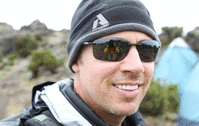 It is estimated that nearly 1 billion people around the world do not have access to one of life’s most basic needs—clean, safe drinking water. As daunting as that sounds, it’s a challenge that can be met in the same way one would summit the world’s most famous high point: one step at a time.
It is estimated that nearly 1 billion people around the world do not have access to one of life’s most basic needs—clean, safe drinking water. As daunting as that sounds, it’s a challenge that can be met in the same way one would summit the world’s most famous high point: one step at a time.
In January 2011, every step Doug Pitt and a team of nearly 50 climbers take up Mt. Kilimanjaro will be a step towards building more than 50 fresh-water wells in Africa through WorldServe International.
The U.S. Goodwill Ambassador for Tanzania, Doug Pitt has a passion for helping people. Husband to Lisa Pitt, and father to three, it was Pitt’s work as a photojournalist that initially drew him to the water needs in Africa after seeing a water well drilling operation on his first trip.
"It is the obvious first step to release people from dire poverty. Clean water must come first." - Doug PItt
Through organizations like World Serve International’s Mt. Kili Climb and Africa 6000, Pitt hopes to drastically reduce the number of children that lack access to clean water in Tanzania and around the world.
For more information about Doug Pitt and contributing to the Mt. Kili climb please visit www.worldserveintl.org.
*******
Online Extra: Political Notes: Lesbian climbs African peak to raise funds for LGBT youth
An exhausted, but happy, Jody Cole holds an Equality California placard on the summit at Mount Kilimanjaro.
It was a climb she initially resisted but turned into a journey aimed at improving the lives of LGBT youth who are struggling with their sexual orientation.
With each step Jody Cole, an out lesbian and former San Francisco resident who now lives in Ukiah in Mendocino County, took up the slopes of Mount Kilimanjaro in Tanzania, Africa earlier this month another dollar was raised for the statewide LGBT lobbying group Equality California.
Returning home from Kenya last September, where she had spent the month, Cole learned about the American LGBT youth who were committing suicide due to being bullied about their sexual orientation or perceived sexual orientation. Each new report about another teenager taking their life devastated Cole, 48, who has long been an LGBT activist.
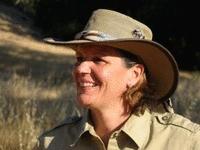 "It makes me sick. I can't believe this has happened," Cole told the Bay Area Reporter in a phone interview from London last week before taking a flight back to California. "It hit me in the gut. I couldn't believe our movement, which experienced AIDS and millions of people dying, it was never supposed to include children. They are not supposed to be killing themselves. Our work should be way ahead of this by now."
"It makes me sick. I can't believe this has happened," Cole told the Bay Area Reporter in a phone interview from London last week before taking a flight back to California. "It hit me in the gut. I couldn't believe our movement, which experienced AIDS and millions of people dying, it was never supposed to include children. They are not supposed to be killing themselves. Our work should be way ahead of this by now."
Cole decided she would try to raise $1 for every foot she climbed on Kilimanjaro. Having ascended the notoriously dangerous inactive stratovolcano in 1998, she was fully aware of how difficult the journey would be. Turning it into a fundraiser, Cole felt it would provide her the motivation needed not to quit.
"Climbing the mountain was fucking hard and I knew it was going to be hard but I knew there was no way the pain I felt climbing that mountain was anywhere near the pain these kids felt to turn to suicide," said Cole. "On summit day I was in unbelievable pain. But I said to myself you got to keep putting one foot in front of the other because my life is so charmed compared to these kids."
*******
Burns Supper on Kilimanjaro
A group of climbers from the Scottish hospitality industry have successfully completed a challenge to hold the world’s highest group Burns Supper on Mount Kilimanjaro.
The group arrived back home yesterday (Tuesday) at Edinburgh airport. The team of 20 people, including two Michelin-star chef Andrew Fairlie and comedian Fred MacAulay, have been raising money for the Hospitality Industry Trust (HIT) Scotland.
They reached the 19,000ft peak of Kilimanjaro on Saturday morning, 10 days ahead of the official birthday of Robert Burns. Due to the weather conditions, the group held their Burns Supper on Friday evening, the night before the final ascent, at the Barafu Camp, 15,500ft up Africa’s highest peak.
Scotland's intrepid climbers followed the full Burns Supper tradition with a haggis created specially by Perthshire butcher Simon Howie. The climb was also supported by two Diageo brands - Johnnie Walker, which was used to toast the haggis, and Guinness, a popular drink in Africa.
Billy Bell from Wine Importers Scotland completed the walk in a kilt and transported his bagpipes up the mountain to play in the haggis. Fred MacAulay acted as master of ceremonies, giving the Selkirk Grace and performing the Ode to a Haggis.
Meanwhile, Callum Ross, who works for Hilton Hotels, gave the toast to the lassies while Annabel Meikle from the Scotch Malt Whisky Society gave the response.
Gleneagles' Andrew Fairlie cooked the haggis in the mess tent with help from the head chef from the African walking company. The whole group, including the porters, sat down to enjoy the traditional Scottish meal and celebrate the works of Robert Burns.
Nineteen of the 20 climbers made it to the top and all were present to take part in the Burns Supper. The challenge was held before Burns' official birthday night because the group had to return to work in their own hospitality businesses.
Together, Simon Howie and Diageo, who also supported the climb through Guinness, donated £40,000 to HIT Scotland. The climbers have already brought in another £50,000 and hope to raise more than £150,000 in total, including future fundraising.
Money raised from the climb will go to the Hospitality Industry Trust (HIT) Scotland, the charity working to raise the ambitions and aspirations of Scotland’s hospitality industry. The charity achieves this by working with colleges and universities and providing scholarships for talented people working in the industry.
Each year the charity holds the Emerging Talent conference to bringing together more than 400 students, professionals and businesses who are interested in raising standards in Scottish hospitality. This year’s event takes place on 9th February in Edinburgh, when HIT Scotland will award over £100,000 worth of scholarships to talented people in the industry.
The record for the highest individual having Burns Supper was set by Chris Dunlop in 2006. The Glasgow climber enjoyed the traditional meal on top of Mount Aconcagua in Argentina at 23,000ft.
David Cochrane, climber and chief executive of HIT Scotland, said: "The trip was unbelievable. We will all remember it forever. The conditions changed from 30 to minus 18 degrees. Some days we were waking up with icicles inside our tents.
"We must have covered between 50 and 60 miles, although it felt like more. We are delighted to reach the top and had a great laugh holding the Burns Supper. There wasn’t a scrap of food left between us.
"We are all looking forward to seeing our families and loved ones. Without their support over the last year we would never have made it to the top."
Butcher Simon Howie said: "Congratulations to all the climbers taking part in this tremendous expedition. I’m delighted to learn that they have succeeded in achieving their objective to hold the world’s highest group Burns Supper at the summit of Kilimanjaro to raise funds for a very worthwhile cause.
"I’m particularly thrilled that our specially prepared Kilimanjaro haggis proved such a hit with the team and to play a part in treating them to a well-deserved taste of Scotland in one of the most exotic locations."
For more information or to make a donation visit, www.hitscotlandappeal.org
The climbers:
Alan Hill is director of food and beverages at Gleneagles. He holds many internationally recognised awards and is a member of the Académie Culinaire de France
Alyson Cawley is a trustee of HIT Scotland and is commercial director for NEC group catering
Elaine Watson is food and beverage trainer at Gleneagles
Callum Ross is responsible for five Hilton Hotels across central Scotland in his role as area general manager
David Cochrane is chief executive of HIT Scotland. He previously worked for Springboard Scotland and Gleneagles
One of Scotland’s best-known restaurateurs, James Thomson owns and runs The Witchery, Rhubarb and the Tower, plus Prestonfield Hotel. He has been involved in a number of charitable initiatives over the years
Mark Forret is Compass Group UK and Ireland’s account director to one of UK’s largest banks
Susan Mathieson is managing director of Event Consultants Scotland, responsible for HIT Scotland’s events throughout the year
Tamara Kobiolke is a senior manager at the Missoni Hotel in Edinburgh
Billy Bell is managing director of Wine Importers and a keen piper
As well as being the director of the Fringe by the Sea, Jane Thomson is also PA to the chairman and managing director of Edinburgh and Glasgow hotel company, The Town House Collection
Annette Lamb is press and marketing manager of Harvey Nichols, Edinburgh
Andrew Fairlie is Scotland’s only two Michelin-star chef for his restaurant at Gleneagles. Every year he welcomes some HIT Scotland scholars to learn in his kitchen
Andrew Chappell is executive director of UK operations at ISS Food & Hospitality
Venue manager for the Scotch Malt Whisky Society, Annabel Meikle will be holding her highest tasting to date
Robert Lynn is from Stag Ltd
Valerie Fotheringham is from Ticketyboo Training
Fred MacAulay is a popular comedian and broadcaster
Jackie Yates, from the Highland sporting estate, Loch Assynt Lodge, Sutherland
Simone Moro, Denis Urubko and Cory Richards: the first winter climb on Karakorum Giants
They were on the top at 11-35 a.m.. It was the first winter ascent of one of the five 8000ers located in Pakistan. Congratulations ! SMS at 2 p.m. (Moscow time): We've found our tent in this terrible storm. THat's all. ...
They were on the top at 11-35 a.m.. It was the first winter ascent of one of the five 8000ers located in Pakistan. Congratulations !
SMS at 2 p.m. (Moscow time): We've found our tent in this terrible storm. THat's all. Tomorrow the descent to BC. THanks for the support.
Denis, SMS to wife: "Summit at 11-35. Going down, 7800. Hope to reach tent before the darkness".
Russianclimb.com
New records of Antarctica
South Pole.
British team sets new speed record for Antarctic crossing. In late November, a group of British adventurers and scientists set off on a mission to the interior of the Antarctic continent in specially designed research vehicles. Their plan ...
British team sets new speed record for Antarctic crossing. In late November, a group of British adventurers and scientists set off on a mission to the interior of the Antarctic continent in specially designed research vehicles. Their plan was to undertake several environmental research experiments while journeying through one of the most in hospitable environments on the planet, but they also managed to set a new speed record for an Antarctic crossing at the same time.
Dubbed the Moon-Regan Transantarctic Expedition in favor of its two organizers, Andrew Moon and Andrew Regan, the plan was for the team to conduct research along the way. For example, they collected samples of the Antarctic snow in order to test the impact of pollutants in the atmosphere of the Southern Hemisphere on the frozen continent itself. They also drove a specially designed snow buggy, powered by biofuels, in order to see how those experimental fuels performed in extreme conditions.
By all accounts, those research elements came off very well, but the real success of the mission was the speed crossing. It took the team just 13 days to drive from the Union Glacier Base to the Ross Ice Shelf, by way of the South Pole, on the far side of the continent. The expedition covered 1209 miles in 303 hours, using specially designed ground penetrating radar to help them avoid crevasses and other obstacles.
The expediton actually reached their destination back on December 9th, but then turned around and made the return trip so that the 10-man team, along with all their research vehicles and gear, could be plucked from the ice by Antarctic-Logistics and Expeditions, a company that specializes in delivering explorers to Antarctica. That happened last week, when the team was returned to Punta Arenas, Chile before making their way back home in time for the holidays.
Taking just 13 days to cross Antarctica is quite an impressive feat. While the team did indeed use motorized vehicles to do it, the terrain that they crossed is quite brutal on any kind of machine and the cold weather played havoc with their engines at times. Throw in the very real danger of driving into a crevasse, and you can start to appreciate the challenges of such a drive. This just might have been the most challenging road trip ever.
*******
Weather blocks expedition team from crossing Antarctica
A Cloudy Antarctica Stymies Solar Snowmobile Trek
A Korean expedition team looking to trek across Antarctica using solar-powered snowmobiles has run into trouble as unseasonably humid weather leaves the usually sunny and clear summer skies overcast and dull.
The expedition, led by veteran mountaineer Park Young-seok, set off from Antarctica’s Patriot Hill in late December on a 1,056km journey to the South Pole, but the from the beginning the team has been beset by difficulties, not least of which is heavy cloud cover – part of the massive storm system causing record rainfall on the Australian mainland – which dumped more snow than the region has seen in 20 years.
The initial idea was to utilise Antarctica’s "endless summer," in which the sun never fully sets from November through until February, a major bonus when running heavy machinery with solar power. But the team’s best laid plans played second fiddle to the weather gods and Antarctica’s white night never eventuated, leaving the team 330km from their destination. Unless they can reach the South Pole by Sunday, they will have to abandon solar-powered sledding and fill their snowmobiles with gasoline to make it back to base camp.
This solar energy-blocking cloud greatly impacted the portable solar recharging equipment for the team's eco-friendly snowmobiles and other camp equipment for much of the time. The solar recharging stations use high-efficiency SunPower solar panels. In full sun they can provide enough power for a three hour drive from a nine hour charge.
Park’s expedition will be made into a documentary for the Seoul Broadcasting System as part of its 21st anniversary year celebrations. They hope the trip will raise the profile of solar energy use in Korea and around the world.--
*******
Norwegian breaks South Pole record
Christian Eide, a 35-year-old expedition leader from Oslo, was still relishing his record-breaking solo trek to the South Pole over the weekend. He arrived at his goal last Thursday, just 24 days, one hour and 13 minutes after leaving Hercules Inlet on December 20, 1,150 kilometers away from his goal.
Oslo expedition leader Christian Eide, after breaking a world record skiing to the South Pole.
His solo world record soundly beat that set by American Todd Carmichael, who used 39 days and seven hours. Eide said he was so excited as he neared his destination that he couldn’t manage to sleep on the last night. He had expected to spend 30 days skiing to the South Pole, so surprised himself with his own speed.
“I just had to keep going,” said Eide, who runs an Oslo-based expedition company called L’atitude. He arrived on Thursday January 13, after skiing alone for three-and-a-half weeks. He average around 47 kilometers a day, but skied around 90 on the last day.
He wrote in his firm’s online diary, though, that he didn’t get a very warm welcome from the Americans running the Scott-Amundsen base. ”I got a strict message that I wasn’t allowed to go inside the base to get my sheet of paper with my official arrival time,” he wrote. “The Americans have decided to have a strict policy towards ‘tourists.’ Is it really necessary to be so unwelcoming? The Americans are otherwise usually very nice.”
On Sunday he was resting after a flight back at the ALE base (Antarctic Logistics & Expeditions LLC) on Union Glacier, where he described spring-like conditions with temperatures as high as minus-7C and sunshine, compared to minus-32 at the South Pole. Around 70 persons were at the base camp, waiting for flights back to Punta Arenas or for new arrivals, and the mood was festive.
Eide wrote that the wait was “perfect” for him, giving him a chance “to relax, calm down, rehash the tour and the result.” He admitted he could still feel the effects of the strenuous tour, and he had some frost and sun damage on his nose.
--
Army amputees to embark on record trek to North Pole with Prince Harry
North Pole.
The Teleragh. A group of Army amputees is to take on one of the most demanding, dangerous and difficult journeys by trekking to North Pole in an expedition that is set to be joined by Prince Harry. If the men reach their target it will be ...
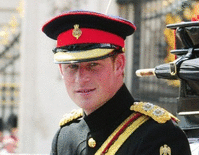 The Teleragh. A group of Army amputees is to take on one of the most demanding, dangerous and difficult journeys by trekking to North Pole in an expedition that is set to be joined by Prince Harry.
The Teleragh. A group of Army amputees is to take on one of the most demanding, dangerous and difficult journeys by trekking to North Pole in an expedition that is set to be joined by Prince Harry.
If the men reach their target it will be the first amputees have ever reached the North Pole trekking unsupported.
But they face many dangers ahead as their injuries make them extremely vulnerable in some of the harshest terrain on earth.
The four men include an officer with an amputated leg, a soldier with a broken back, a paratrooper with a partially paralysed arm and another with an amputated arm.
The month-long expedition will cover 300 miles of the frozen Arctic Ocean enduring temperatures as low as -50C. They will have to navigate over vast swathes of ice rubble and pressure ridges while avoiding aggressive polar bears, falling through ice and fighting off hypothermia.
The men will pull their own equipment and food in sleds weighing in excess of 100kg
‘Walking with the Wounded’, supported by Artemis, plans to raise £2 million for military charities including the British Limbless Ex Service Men’s Association and Help for Heroes.
Prince Harry, who as patron of the expedition plans to walk the final leg just before his brother’s wedding, said: ‘This polar adventure will exemplify the tenacity and courage of those who serve in uniform. I urge the public to get behind them.”
During the bloody battles of Operation Panther’s Claw in 2009 Capt Guy Disney, 28, of the Light Dragoons, lost his right leg below the knee after he was hit by a rocket-propelled grenade.
His biggest concern will be the sweat inside his stump turning into ice that could lead to frostbite.
“It will be hard and there are a few people with concerns,” he told The Daily Telegraph. “But we are not racing to get there and I’m not sure I will find it the toughest as Steve (Young) has a broken back.”
Sgt Steve Young, 28, was also injured during Panther’s Claw sustaining a complicated fracture of the vertebrae when he was hit by an IED (improvised explosive device). The Welsh Guards soldier was told that he may never walk again but last summer managed to run the Safaricom half marathon in Kenya.
Pte Jaco Van Gass, 24, was also hit by a RPG and lost his left arm that will make him vulnerable if he falls through thin ice. But the paratrooper said the expedition was a “once in a life time opportunity”.
“I want to prove, not just to myself, but to all the other wounded men and women that you can do whatever you set your mind to and that life goes on after injury.”
Capt Martin Hewitt, 30, was shot in the shoulder as he led a bayonet charge against a Taliban post in 2008 and decorated twice for bravery. “This expedition is an amazing opportunity to achieve something truly special and raise the profile of those injured on operations in service,” the Parachute Regiment officer said.
The adventurer Bear Grylls called it an “epic challenge for a vitally important cause”.
Brigadier Ed Butler, the former British commander in Helmand, said: ‘Rehabilitating the wounded back into a non-military workplace is a huge task the nation faces in these modern tim
Everest 2011: when people want more than just reach the top
Vinson.
There is a group of climbers, that every year come to Everest planning to make something amazing. Englishman David Tait intends to make two climb to the summits above eight thousand meters. First, he plans to climb a new route on Lhotse, ...
There is a group of climbers, that every year come to Everest planning to make something amazing. Englishman David Tait intends to make two climb to the summits above eight thousand meters. First, he plans to climb a new route on Lhotse, then on Mount Everest without artificial oxygen. 69-year-old American Bill Burke with Mexican David Liano intends to make two ascents of Everest during the spring season, from two different sides. The first – by the northern route from Tibet and the second - from the south, from Nepal. 46-year-old Englishman Paul Parkinson has announced his intention to climb the western ridge of Everest solo, without oxygen and in the clothing of twenties of the last century.
George Atkinson from England plans to become the youngest conqueror of the Seven Summits, his ascent of Everest, he would commit to 29th May, when he turns 17 years old. However, he has a rival. This Romanian girl Crina Popescu, who is now in Antarctica with the 7 Summits Club. She turns 17 years until December 2011. She has currently six summits of the Seven Summits project, missing just Everest. And she plans it also for spring 2011.
David Tait with his partner Phurba
Bill Burke from California
David Liano
In our expedition led by Alex Abramov, also we will have climbers who plan to go not by the classic ways. Gleb Sokolov and Vitaly Gorelik from Siberia, plan to open a new route on the East Face of Everest, to the right of the American routes. The second idea is to make traverse of Nothern Peak of Everest to the Main Summit.
*******
BBC
Surrey teenager George Atkinson aims to conquer Everest George Atkinson has recently returned from climbing Mount Vinson in Antarctica
Sixteen-year-old George Atkinson from Surbiton is aiming to become the youngest person to climb the Seven Summits - the highest mountain on every continent.
He has just returned home from Antarctica and scaling Mount Vinson, his sixth successful climb.
He got the mountaineering bug from his father Mark, and by the age of 7 he had climbed the three highest peaks in Scotland, England and Wales: Ben Nevis, Scafell Pike and Snowdonia.
George told BBC Surrey: "My father really got me into climbing. When I was six we climbed Slieve Donard, the highest mountain in Northern Ireland.
"We did that because we needed to find something we needed to do together. I really loved it."
He started off his challenge when he climbed Mount Kilimanjaro in Kenya at the age of 11 in 2005, before scaling Europe's highest peak, Russia's Mount Elbrus, in 2007.
He then tackled Puncak Jaya, also known as Carstensz Pyramid in Indonesia in 2008, followed by the South American peak Aconcagua later in the same year.
"There are a number of things that drive me. I do enjoy any mountain and I feel there is an amazing sense of freedom in any mountain range.
"I like a good challenge in life and the Seven Summits is something which gives me that.
"I find these mountains to be a good adventure by going off to exotic places and it's a good chance to travel the world."
George ticked off his fifth peak when he climbed Mount McKinley (known as Denali) in North America.
"Denali has been the toughest so far. It was full-on mountain climbing," he said.
"You land on a glacier and spend 18 days living in the snow pulling everything you need for the expedition with you, and you have to bring it back down with you.
George on top of Denali last year
"It was harder physically and the weather was more extreme."
George is now preparing for his final climb. He will tackle Mount Everest in Nepal, which at 8,850 metres is the highest mountain in the world.
He aims to climb Everest in April or May this year, and if he is succeeds in his ascent before his 17th birthday on May 29, he will become the first person do climb every summit in the world before the age of 17.
"I have a training regime which I'm trying to keep up to. I go running twice a week to increase my lung capacity and go to the gym three times a week.
"It would mean an awful lot to get to the top of Everest. I'm not doing it just to get the record.
"I find it a good challenge. If I got the record it would be the cherry on top and finish it off well."
Explorer will attempt first solo January ascent of McKinley
HIGH RISK: Lonnie Dupre cites historic climbers as inspiration. January 7th, 2011-- Polar explorer Lonnie Dupre departed today for the Kahiltna Glacier located at the base of Denali, aka Mount McKinley, in Alaska. Dupre is attempting the ...
HIGH RISK: Lonnie Dupre cites historic climbers as inspiration. January 7th, 2011-- Polar explorer Lonnie Dupre departed today for the Kahiltna Glacier located at the base of Denali, aka Mount McKinley, in Alaska. Dupre is attempting the first solo January ascent of Denali.
By adn.com. A Minnesota man known for his polar adventures got an extra day Wednesday to think about -- and fatten up for -- his quest to become the first person to make a solo ascent of Mount McKinley in the dead of winter.
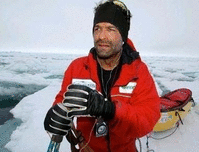 A storm delayed Lonnie Dupre's plans to leave Talkeetna for the mountain. He said in a telephone interview that he'd use the time to shovel in more calories to fuel his body for a trek that is likely to last three or four weeks.
A storm delayed Lonnie Dupre's plans to leave Talkeetna for the mountain. He said in a telephone interview that he'd use the time to shovel in more calories to fuel his body for a trek that is likely to last three or four weeks.
If the delay also fueled his anxiety over the high-risk climb, he wasn't letting on.
"It's good to have a little bit of nervousness going into it, because you always have that going into a project that's on the edge," Dupre, 49, said. "But once you get there and kind of get in tune with your environment, then you begin relaxing.
"... I'm not even thinking about the summit, actually. I'm just thinking about getting out there and doing some winter camping and moving my little legs in the right direction."
Dupre hopes to go where few men and no women have gone before: to the top of 20,320-foot McKinley in the winter.
To make things more interesting, he plans to go alone and in January -- something that only a few others have tried, none of them successfully.
Of the 16 people who have stood atop McKinley between the winter solstice and the spring equinox, only four made the trip alone, and the body of the first -- Japan's Naomi Uemura, who died on his descent -- remains somewhere on the mountain.
Only one team has reached the summit in January, when 5 1/2 hours is it for daylight -- Russians Artur Testov and Vladimir Ananich on Jan. 16, 1998. On March 8 of that same year, Japan's Masatoshi Kuriaki reached the summit to become the fourth man to make a solo winter ascent.
No one has successfully climbed North America's tallest peak in the winter since then, though there have been several attempts.
"We always seem to have anywhere from one to four or five people each winter," said Missy Smothers of the Denali Park Service. "It's exciting, but we always hold our breath."
And for good reason.
There are no rangers and no base camp operations on McKinley during the winter, when whiteouts, howling winds and deep snow make travel more treacherous than usual. Of the 16 who have summited in the winter, two died on their way down. Another four died on their way up, including a member of the expedition that put Dave Johnston, Art Davidson and Ray Genet on the summit in March 1967, marking the first winter ascent of the mountain.
Dupre, who lives in Grand Marais, Minn., knew about some of Denali's winter history when he decided this summer, shortly after his first McKinley climb, to make a solo winter attempt.
"Actually, Naomi Uemura was an inspiration to me years ago because he was first a polar explorer," Dupre said. "I knew about his death on Mount McKinley back in 1984, and it's always been on mind -- Naomi and that mountain -- since 1984."
Dupre worked as a commercial fisherman in Bristol Bay from 1983 to 1986, a period during which he spent the winter of 1985 by himself in the Brooks Range.
"That started everything rolling," he said. "I've been running around the Arctic and polar regions now for 25 years."
Dupre's resume is an impressive one. In 2006, he and Eric Larsen of Grand Marais traveled 600 miles from Canada to the North Pole, pulling and paddling canoes over shifting sea ice. In 2001 he and John Hoelscher of Australia became the first people to circumnavigate Greenland, dogsledding and kayaking the 6,517 miles in three stages. In the winter of 1991-92, he and Malcolm Vance of Shishmaref mushed 3,000 miles from Prudhoe Bay to Churchill, Manitoba. And in 1989, he was a member of the Bering Bridge Expedition that mushed and skied 1,000 miles along the Siberian and Alaska coasts.
"I love winter," Dupre said.
He knows how to travel, camp and survive in temperatures that plummet well below zero.
But he isn't a mountain climber.
"I did a little training prior to June and then came to Denali," Dupre said. "We had some basics of mountaineering, and we just decided to be cautious and take our time and we were successful. We made it to the summit in 13 days.
"... As I was traveling up the mountain, I started thinking maybe I should make an attempt to do Denali in the winter."
Along the way, Dupre met Vern Tejas, who in March 1988 became the first person to make a successful solo winter ascent of McKinley. Uemura made it to the top of Denali on his solo trip in February 1984, but because he died on his way down, his is not considered a "successful" ascent.
"I visited with Vern quite a bit on Denali last spring," Dupre said. "I picked his brain a little about snow caves and about the route."
Back in Minnesota after his climb, Dupre started planning a return trip to McKinley. He contacted Tejas and Testov, who may be Denali's most experienced winter climber, having made four attempts and succeeding once. Last March, Testov and partner Christine Feret spent 12 days trapped in a snow cave at 10,000 feet before turning back.
"We threw a bunch of information back and forth, and I think I've got a good game plan," Dupre said.
Dupre said he chose to climb in January not so much because he could make history with the first solo ascent in the dead of winter but because he thinks he might get better weather than if he waited until February or March, when there is more daylight.
"I've done a lot of travel in the winter, and the dark part doesn't bother me," he said. "When I did a little research, I learned there's a little less precipitation in January, which means less snow, which means better visibility."
He'll pull a sled packed with 175 pounds of gear and supplies up the popular West Buttress route. He said he has enough food and fuel to last 38 days, though he's hopeful he won't be on the mountain that long.
"My first goal is the 7,800 (foot) mark, which is before you start climbing up the glacier," Dupre said.
After that, his plan includes stops at 9,700 feet, 11,200 feet, 13,500 feet, 14,200 feet, 17,200 feet, "and then the summit," he said.
Mount McKinley winter ascents
A climb is considered a winter ascent if the summit day falls between the Dec. 21 winter solstice and the March 21 spring equinox. Though numerous winter attempts have been made, only 16 climbers have made it to the summit. Six have died in the attempt, including three Japanese climbers who died on the West Buttress somewhere between 16,000 and 18,200 feet on Feb. 22, 1989.
Nine expeditions have put men atop McKinley in the winter:
• Feb. 28, 1967 -- Americans Dave Johnston, Art Davidson and Ray Genet, West Buttress route. Team member Jacques Batkin of France died on the ascent.
• March 7, 1982 -- England's Roger Mear and American Mike Young, Cassin Ridge.
• March 11, 1983 -- American Charlie Sassara and Robert Frank, West Rib. Frank died on the descent.
• Feb. 12, 1984 -- Japan's Naomi Uemura, West Buttress. Uemura vanished on the descent between 16,000 and 18,200 feet. First solo ascent.
• March 7, 1988 -- American Vern Tejas, West Buttress. First successful solo ascent.
• Feb. 20, 1989 -- Austrians Steinmassle Helmut, Helmut Mittermyer and Laserer Walder, West Buttress.
• March 11, 1989 -- American Dave Staeheli, West Rib.
• Jan. 16, 1998 -- Russians Artur Testov and Vladimir Ananich, West Buttress. First ascent in dead of winter.
• March 8, 1998 -- Japan's Masatoshi Kuriaki, West Buttress.
Source: Denali National Park
Hall of Fame NFL players will climb Kilimanjaro to benefit soldiers…
Kilimanjaro.
Our story began with a casual conversation. Ken Huff was telling a friend about the time he climbed Mount Kilimanjaro a few years ago. It was, Huff told his friend, "an absolutely phenomenal experience." Well, ya think? Kilimanjaro rises ...
Our story began with a casual conversation. Ken Huff was telling a friend about the time he climbed Mount Kilimanjaro a few years ago. It was, Huff told his friend, "an absolutely phenomenal experience."
Well, ya think? Kilimanjaro rises 19,341 feet above Tanzania. It is the highest mountain on the continent of Africa; climbers who reach its peak can look down on the clouds.
That experience alone can put any number of things into perspective, including the relative importance of "fame" — in this case, the 11 years Huff spent in the National Football League as a guard for the Baltimore Colts and Washington Redskins.
"You feel so insignificant. You're so high up. You see the majestic view, the sun coming up over the sea of clouds," Huff said. "You realize you really are on top of the world. We're put on this planet — this huge, wonderful planet — and we're just passers-by."
Huff's friend wondered if he'd ever again want to tackle the mountain. He thought about it a moment, then answered, "Yes, if we did it for a reason instead of just doing it."
Grand ideas are born from such moments. Huff, indeed, is going back to Kilimanjaro in February and he'll take several companions along for the climb, among them former Buffalo Bills and Hall of Fame guard Joe DeLamielleure, 59, and a gentleman named Tommy Rieman.
Rieman is a sergeant in the U.S. Army and was awarded the Silver Star after he was shot twice and sustained 11 shrapnel wounds during a battle in Iraq. He also helped set up a perimeter during the battle so medics could safely evacuate other wounded.
Rieman spoke at the Hall of Fame dinner when the Super Bowl was in Tampa two years ago. DeLamielleure was in the crowd that day and the two have been friends since.
"Joe's always up for something crazy," Rieman said.
That's certifiable. Recently, DeLamielleure and a couple of college roommates rode bikes about 2,000 miles from Michigan to Mexico for a good cause. It was the first time he had done something like that. Who's going to back down from a mountain now?
"He called me up and said, 'I want you for this,' and I'm like, 'OK,' " Rieman said. "Neither of us has climbed before, but if you can achieve the summit you can do anything. That's the message we're trying to send."
As if surviving two bullets and 11 pieces of shrapnel while saving several fellow soldiers isn't message enough.
"Sometimes when I get introduced, they call me a hero. Hero, my butt," DeLamielleure said. "I'm an entertainer. I'm an offensive guard who played football. Tommy guards our country. Hearing his story got me very motivated."
That's how it works. One step leads to the next one, and now the reason Huff needed to climb Kilimanjaro again has been realized. He and his fellow hikers will raise money to benefit Wounded Warriors, a private operation that provides help to severely injured soldiers.
"I don't think God put me in the Hall of Fame just because I played football," DeLamielleure said. "We can do a lot of good with our notoriety."
If you can think of a better gift in this season of giving, it must be really special.
"Just because someone is wounded, life isn't over," Huff said. "There is still a lot they can do. I played golf about a month ago with a triple-amputee — lost both of his legs and one arm. He has three artificial limbs and he's a single-digit handicapper, and I'm lucky to break 100."
Huff, 57, and friends are counting on the publicity from this climb to spur donations for the cause. They've set up a website — bootsandcleatsonthesummit.com — to provide additional info about the project as well, of course, as a place to contribute money.
There are many Wounded Warrior chapters, including one in Clearwater. You may have seen them at such events as the Gasparilla Distance Classic. They are amazing people, both those who give and those who receive.
That takes us back to the mountain, which serves as both a metaphor for this story and real-life challenge. Kilimanjaro can be tamed, but not without a fight. An estimated one-third of those who try to scale it fall short. Recently, Martina Navratilova abandoned her quest to get to the top when one of her lungs collapsed in the thin air.
"It's the most physically demanding thing I've ever done, all (NFL) training camps included. It's all because of the lack of oxygen and altitude," Huff said.
"The last mile you hike, they wake you up at midnight and you start hiking at 1 a.m. because there's more oxygen in the air at that time. You arrive at the summit at sunrise, above the clouds. It's hard to describe what that is like. You are literally on top of the world."
That's where we came in. Someone asked Ken Huff if he'd climb Kilimanjaro again and he answered yes. All he needed was a reason, and now he has one.
"I just like doing stuff," he said.
It's a lot more than just that.
"People take for granted the freedoms we have," DeLamielleure said. "We have to remember the sacrifice these guys have made for us. We have to help them."
By JOE HENDERSON | The Tampa Tribune Published: December 24, 2010
South Pole: Richard Parks reaches the Pole, a loss in the Austrian ORF team
South Pole.
www.737challenge.com. 27th December 2010. Richard Parks completed the first leg of his world first 737 Challenge this morning, arriving at the South Pole and completing the first of 3 poles he will face during his 7-month race to ...
www.737challenge.com. 27th December 2010. Richard Parks completed the first leg of his world first 737 Challenge this morning, arriving at the South Pole and completing the first of 3 poles he will face during his 7-month race to climb the highest mountain on each of the world’s continents and venture to The South and Geographical North Poles.
Richard arrived at the pole at 6.10 am UK time, 3.10am Chilean time and 7.10pm local time.
Richard will now stay on the South Pole, the southernmost point on the surface of the Earth until January 1st to ensure he reaches all poles within the same calendar year, ensuring his world record is complete at the end of the challenge.
The world's 3 Poles are The South Pole, The Geographic North Pole and the summit of Everest. The top, bottom and roof of the world. Today marked a historical day for Richard and his incredible world first expedition.
Richard Parks
BORN IN PONTYPRIDD, WALES, 14TH AUGUST 1977.
Richard Parks is a former Welsh international rugby player, earning caps against South Africa, Fiji, Scotland and Ireland. He also represented the Barbarians and Wales Sevens on the IRB world circuit and in the World Cup.
--------------------------------------------------------------------------------------------------------------------------
December 26 Two teams of Austrian and German television (ORF and ZDF) have passed the midpoint of their media race "Wettlauf zum Südpol". The full length of the route - 400 km. In accordance with the plan at half-way a stop has been made. Primarily for medical purposes. Doctors banned from further participation Alex Serdyukov from the team of Austria due of frostbitten fingers. They are confident that everything will be without serious consequences. Last part or route, Sabrina Grillitsch, Tom Walek and Hermann Maier will go at three. This is a minimal quantity for allowed for finish.
The Highest Art: 78-Year-Old Painter Ranan Lurie Plans Exhibition on Top of Mount Everest
Everest.
Associated Press. NEW YORK — True art can be an elevated pursuit — in this case an elevation of approximately 29,000 feet. Three small panels of a massive painting project that has been displayed at the United ...
Associated Press. NEW YORK — True art can be an elevated pursuit — in this case an elevation of approximately 29,000 feet. Three small panels of a massive painting project that has been displayed at the United Nations are set to be carried to the top of Mount Everest in March, artist and political cartoonist Ranan Lurie said Wednesday.
The three acrylic-on-canvas panels — together measuring about 2 feet by 3 feet — represent just a small fraction of the dozens of pieces making up the 600-foot-long "Uniting Painting" project.
The 78-year-old artist, who's been working on his "Uniting Painting" project since 1968, says it offers viewers a "common denominator."
By enjoying the different pieces of the artwork, he said, "we respect the same thing."
"Although we come from different cultures and different places," he said, "we have an artistic Esperanto that we can talk through and with. And unite."
Lurie says he hopes that displaying the paintings on the peak of the world's highest mountain will show the scope of the work's message.
The project's dozens of panels depict similar flowing shapes that continue from one panel to the next, though the colors and motifs change. The panels selected to be carried by professional Nepalese climbers are largely blue and white to reflect the colors of clouds, sky and snow found at their destination, Lurie said.
----------------------------------------------------------------------------------------------------------------------------
News Aconcagua: A Prime Minister from Europe on the way to the summit !
Aconcagua.
Tomorrow a representative delegation leaves Mendoza in the direction of Aconcagua. It is a team from Belgium, consisting of about 30 people. Among them, the most senior official person of the country for this moment. It is the Prime ...
Tomorrow a representative delegation leaves Mendoza in the direction of Aconcagua. It is a team from Belgium, consisting of about 30 people. Among them, the most senior official person of the country for this moment. It is the Prime Minister of Flanders, 48-year old Kris Peeters.
The expedition set the task to climb Aconcagua. 15 members of the team in one or another way are affected by asthma. Actually, the main goal -it is not even the climbing. This is a demonstration to all the people whose lives are complicated by the different diseases that an active lifestyle, sports - it's not just possible, they need it.
In airport
By the way, Mr Peeters is a great friend of Russia. He was elected an honorary doctor of MGIMO University of Russia, often visiting in our country. The last time in October, Mr. Peeters held talks in St. Petersburg with the local authorities. As always, he came with a mass of concrete and constructive proposals.
Kris Peeters is not particularly fond of climbing, to his credit is only an ascent of Mont Blanc. He is known as the past athlete and a big fan of cycling. Until 2004 Peuters with his economic and philosophical education, worked in various business communities, including at European level. In 2004 he became minister of the environment in Flanders, and quickly became famous due his courage, radicalism and consistency. Proclaiming the highest standards in Europe, environmental protection, he did not leave it in words. Therefore, Mr. Peeters became in 2007 the prime minister of Flanders.
Among asthmatics participating in the expedition, only three have climbing experience. Others, primarily engaged in cyclic sports. Undoubtedly, the most important part of the team are physicians, as well as video operator. In short, it is a solid event and, as usual, they use money collected for charitable purposes.
We wish you success, my friends!
Moscow: An honorary doctor of MGIMO University of Russia, in international relations
How Element3 became Element4 for Swiss climbers of Aconcagua
Aconcagua.
Three young persons from Swiss invented a rather original program for their trip. Three elements, three ways to travel, and all without motorized means, without hotels and restaurants, without guides or porters. From the doors of their ...
Three young persons from Swiss invented a rather original program for their trip. Three elements, three ways to travel, and all without motorized means, without hotels and restaurants, without guides or porters. From the doors of their homes - to the summit of Aconcagua. This means: from the resort of Nendaz in Pennine Alps, first to the French port of Camargue by bikes (600 kms), then across the Atlantic Ocean on a simple boat (up to Buenos Aires - more than 11 thousand kilometers), then again by bicycle to the gates of the Aconcagua National Park (about 1000 kms). And further, a start of a climbing program, high-altitude climbing to the highest summit of South America. They called their project elenent3 and site - elenent3.ch.
All three adventurers are medicine workers, and age mates, they are 29 years. Jessica Mermoud was born in Montreux, was educated in Lausanne and then moved to the mountains to work. Guenole Addor (center) was born in Lausanne, however, spent much time in the homeland of his ancestors in Britton, on the archipelago of Glenanes. There he was accustomed from childhood to seamanship, was engaged in yachting, what, in fact, has become a key point in creating a new project elenent3. Pierre Metrailler also studied medicine in Lausanne, but later mastered another profession. In 2007 he became a professional mountain guide.
It so happened, that in their journey "the fourth" element was involved. Damage of boat and bad weather delayed travel on the islands of Cape Verde. The delay was three weeks long. They had to change travel plans. So there appeared a "fourth element" - a South American bus. This simple popular form of transportion has been chosen as a compromise, the main thing - do not go by plane. Friends crossed Atlantic Ocean and landed in the Brazilian port of Salvador. From there they reached a sity of Mendoza by different buses travelling about 5,000 kms
In itself, this is an amazing adventure.
A route according a plan
As a result, the team saved a few days, which were used for acclimatization ascent to the top of Cerro Valesitos (5400m). After that, they were joined by Guenole’s girlfriend Sylvia. And at four, they went in the direction of Aconcagua, highest peak in South America ...
Martina Navratilova on road to recovery as she leaves Nairobi hospital
Kilimanjaro.
NAIROBI, December 12, 2010 - Martina Navratilova was today discharged from Nairobi Hospital, after making a good recovery from high altitude pulmonary oedema, an accumulation of fluid on the lungs, which she developed while climbing Mt. ...
NAIROBI, December 12, 2010 - Martina Navratilova was today discharged from Nairobi Hospital, after making a good recovery from high altitude pulmonary oedema, an accumulation of fluid on the lungs, which she developed while climbing Mt. Kilimanjaro in Tanzania to raise funds for the Laureus Sport for Good Foundation.
Martina's team of Laureus fundraisers, including German Paralympic Cyclist and Laureus Friend & Ambassador Michael Teuber and British Olympic badminton star Gail Emms reached the summit of 19,341ft Mt. Kilimanjaro yesterday despite battling severe weather conditions on the mountain. In total, 18 of the 27 fundraisers reached the top.
Martina was in high spirits on leaving the hospital, she said: "I am feeling much better and really pleased to be going home. I'd like to thank all the staff at Nairobi Hospital, who were wonderful, and really took care of me. The care I received during my three days in hospital was excellent.
"I have also been very touched by all the messages of support I have received over the past few days, and want to thank Laureus Academy Chairman Edwin Moses in particular, for making a very early morning call from Atlanta today to wish me well. It was great to chat to him, although I did joke that perhaps I have gone above and beyond the call of duty for Laureus on this occasion!
"It's great to know that the team have all returned safely from the mountain. I was so pleased to hear that so many of them made it to the summit despite the weather conditions, and I hope people reward their efforts by continuing to donate at http://www.laureus.com/"
Martina, who was leading the team of fundraisers, was forced to abandon the climb on day four. She was assisted down the mountain by porters and driven to nearby Kilimanjaro Christian Medical Centre for assessment, then, as a precaution, she was flown to Nairobi hospital for further tests which showed she was suffering from high altitude pulmonary oedema.
The climb began on Monday (Dec 6), and the Laureus team have had to face blizzards and torrential rain, which made progress extremely difficult throughout the week. The group of fundraisers safely reached the base of the mountain earlier today, and were delighted to hear news that Martina had been discharged from hospital.
German Paralympic Cyclist and Laureus Friend & Ambassador Michael Teuber, said: "It is fantastic to return to the news that Martina is getting much better and has been able to leave hospital. We were of course all very concerned for her and sad that she was forced to abandon the climb, but are delighted to know that she is now on the mend."
Martina Navratilova and Edwin Moses are members of the Laureus World Sports Academy, a unique association of 46 of the greatest living sporting legends who volunteer their time to act as global ambassadors for the Laureus Sport for Good Foundation. The mission of the Laureus Foundation is to utilise the power of sport to address social challenges, such as HIV/AIDS, substance abuse, crime, social exclusion, landmines awareness, violence, discrimination and health problems such as obesity through a global programme of sports-related community development initiatives. Currently there are almost 80 projects around the world supported by Laureus. Since its inception Laureus has raised over €35 million for sports-based projects which have helped to improve the lives of more than one million young people.
www.laureus.com/
Main prizes of 2010 for climbers of Russia (and Ukraine)
Piolet d' Or of Russia will go to Irkutsk (Siberia, Baikal region). Denis Veretenin and Eugene Bashkirtsev received it for their climb of Selestal Peak in China. Prize "Steel Angel" for achievements in mountaineering among women was awarded ...
Piolet d' Or of Russia will go to Irkutsk (Siberia, Baikal region). Denis Veretenin and Eugene Bashkirtsev received it for their climb of Selestal Peak in China. Prize "Steel Angel" for achievements in mountaineering among women was awarded to Marina Kopteva (Kiev, Ukraine). For a solo climb on Morcheka Wall in the Crimea.
"Crystal Peak", a prize awarded by vote of website users of Risk.ru went to women's team: leader Marina Kopteva, Anna Jasinskaya (both from Kiev), Galina Chibitok (St. Petersburg) for West Face of Amin Brakk in Pakistan.
Brothers Nefedovs (Sergey and Andrey) from St. Petersburg, won a Risk.ru prize “for the best project”, for the first free climbing of the route Machombo on Morcheka.
Photos from Risk.RU
Piolet d' Or of Russia from Grivel
Denis Veretenin (right) and Eugene Bashkirtsev
Light style on Selestal Peak
Marina Kopteva - the main person in the party
West Face of Amin Brakk
Machombo on the Morcheka Wall in the Crimea - now free by Nefedovs brothers
Andrey (left) and Sergey Nefedov
Ueli Steck as a guest of Russia
with Andrey Volkov - the president of Russian Mountaineering Federation
Richard Parks ready to take on the world
South Pole.
In the third of his BBC columns, Richard talks about his final preparations for his '737 Challenge' during which he aims to climb the highest mountain on each continent, plus reaching both the South Pole and the North Pole for charity - all ...
In the third of his BBC columns, Richard talks about his final preparations for his '737 Challenge' during which he aims to climb the highest mountain on each continent, plus reaching both the South Pole and the North Pole for charity - all within seven months in a bid to raise £1m.
The clock is now ticking towards 12 December when I fly to South America and then Antarctica on the way to the start of this most gruelling of challenges.
It's just mind-blowing to think how quickly the challenge has come round from conceiving it 15 months ago. I'm both scared and excited, but just want the whole thing to start.
I've done all the training now and I don't think I can do any more. I feel physically and mentally prepared for the challenge, which if successful will see me become the first person to stand on the continental summits and the poles in the same calendar year.
The challenge consists of the South Pole, Mount Vinson (4,897m), Aconcagia (6,962m), Mount Kilimanjaro (5895m), Carstensz Pyramid (4,884m), the North Pole, Mount Everest (8,850m), Mount Denali (6,194m) and Mount Elbrus (5,642m).
If all goes to plan I'll be at the South Pole on 1 January and finish up at the top of Mount Elbrus on 31 July.
Over the last few months, and especially my final training on Cho Oyu in the Himalayas, I have developed this toolbox of mountaineering skills that will give me the best chance of success. But ultimately we are in the hands of mother nature and she could put a spanner in the works!
Since coming back from the Himalayas in October there has been no let up in attempting to boost my aerobic capacity. I competed in the Cardiff half marathon and then took part in the Cardiff Burn - a 10k run, a 42k bike and a 3k kayak. That was hard, but great preparation.
Everest would seem to be the biggest challenge but we have highlighted Denali as the toughest leg because in it's a brutal mountain in its own right
But I did have a setback when I lost my training partner on a run on the Ogmore coastal trail. Unfortunately my dog Ben fell down a hole and broke his leg. He's feeling a bit sorry for himself but he'll be okay.
The last couple of weeks I have been trying to taper down the training and have given Kevin Morgan, the former Wales international full-back who is helping me train, something of a poser.
I told him I want to be fit and fat before I go! I want to maintain my fitness but also to go into the challenge carrying a bit of extra weight with a big intake of carbohydrates.
A lot of my energies have been put in to the packing and sorting my gear out. I have to pack bags now that will be air freighted on to Everest base camp. Packing for nine legs over seven months is pretty challenging to say the least.
And on the other hand is the charity. I recently visited the cancer day care centre which was a real humbling experience and gave me some real inspiration for my trip.
I have spent every penny I have and every waking hour of the last 15 months on this unique challenge because I am very serious about it and its integrity. I was very down after my rugby career was ended with a shoulder injury and this has given me something to focus on.
At half-time during the Wales v New Zealand international at the Millennium Stadium I was presented with a special badge by Carwyn Jones, Wales' first minister, and WRU chief Roger Lewis. To get the ovation I did from the 70,000-odd fans in the stadium was a real lift.
After leaving on 12 December I don't get much thinking time because I'll be in Antarctica on 14 or 15 December and straight into the challenge. The plan is we get to the South Pole on 28 December.
And that poses a problem because I will have to wait there until 1 January so it qualifies with the calendar year requirements of the challenge. That has been one of the logistical hurdles I've had to overcome and I will have to get a flight back on my own on a supply plane.
Then it's back to Mount Vinson on Antarctica and then on to Aconcagia in South America - the highest mountain outside the Himalayas.
The crux of the challenge is further down the line - the North Pole, followed by Mount Everest and then on to Mount Denali. The North Pole presents the highest risk of cold or frost injury, and every day we are battling the north pole we are missing a day acclimatising on Everest.
Everest would seem to be the biggest challenge but we have highlighted Denali as the toughest leg because in it's a brutal mountain in its own right. Extreme weather systems and I will be doing it at my weakest mentally and physically because I will be coming straight off Everest.
We are aiming to be on Everest in April and May. Statistically the highest summit success rate is early May and after that we are looking at four to six days to climb Denali.
The aim then is to reach the summit of Mount Elbris before 31 July.
Richard Parks was speaking to BBC Sport Wales' Richard Thomas
Source:
http://news.bbc.co.uk/sport2/hi/rugby_union/welsh/9239634.stm
Changes in the program 7 volcanoes: the highest volcano of Asia is in China
Sidley.
The program "Seven Volcanoes" is relatively young. American Amar Amdalkar posted great material about it on the pages of his excellent site skimountaineer.com. We, in the 7 Summits Club, rather uncritically copied the list and took it for ...
The program "Seven Volcanoes" is relatively young. American Amar Amdalkar posted great material about it on the pages of his excellent site skimountaineer.com. We, in the 7 Summits Club, rather uncritically copied the list and took it for granted. However, refinement began to appear. The first was Mount Giluve in Papua, as the highest volcano in Australia. And now it appeared quite clear that the highest volcano in Asia is in China, in the mountains of Kun-Lun. Ka-er-daxi is 5808 meters high.
------------------------------------------------------------------------------------------
Kunlun Volcano is located in Tibet. The volcanic group contains 70 pyroclastic cones and basaltic lava flows. Ashi Shan volcano in the western end of the group is the youngest volcano in China (also known as Ka-er-daxi or Vulkan).
1951 Eruption
The eruption of Kunlun in 1951 was the most recent eruption in China. It was a central vent explosive eruption witnessed by road building workers.
The Kunlun Shan is a major mountain system of Asia, situated in China about halfway between the Himalayas and Tian Shan. It stretches one thousand miles, its snow-and-glacier-clad peaks rising abruptly along the north edge of the vast dry Tibetan plains.
The Kunlun Shan becomes progressively more narrow from east to west, and the narrow western section, just east of the Pamirs, is where the highest peaks are found, towering seventy five miles south of Kashi, the largest city in western Xinjiang Province, China. Near the center of the Kunlun Shan, a 500-mile northern branch called the Altun Tagh splits from the main range and extends northeast.
http://www.summitpost.org/vulkan-ka-er-daxi/464166
This peak is to the best of my knowledge, unclimbed. If it is and the Xinjiang Mountaineering Association decides to follow the rules strictly, the peak fee will be 4400-10255$US! The peak is very small compared to its neighbors and you may be lucky and not charged at all for climbing it. Sometimes you can climb peaks below 6000m with no charge.


